Alternative Intersections/Interchanges: Informational Report (AIIR)
CHAPTER 2. DISPLACED LEFT-TURN INTERSECTION
2.1 INTRODUCTION
The DLT intersection, also known as a CFI and a XDL intersection, has been implemented at several locations in the United States to reduce congestion. The reduction in the numbers of traffic signal phases and conflict points at DLT intersections can result in improved traffic operations and safety.
The main feature of this alternative intersection is the relocation of the left-turn movement on an approach to the other side of the opposing roadway, which consequently eliminates the left-turn phase for this approach at the main intersection. As shown in figure 3, traffic that would normally turn left at the main intersection first crosses the opposing through lanes at a signal-controlled intersection several hundred feet upstream of the main intersection. Left-turning vehicles then travel on a new roadway parallel to the opposing lanes and execute the left-turn maneuver simultaneously with the through traffic at the main intersection. (1) Traffic signals are present at the main intersection and at the locations of the left-turn crossovers. The traffic signals are operated in a coordinated manner. The left-turn crossover movement, opposing through movements, and signal control at the crossovers and the main intersection are shown in figure 4. In the figure, the red circle indicates a signal-controlled crossover, the blue hatched circle indicates a signal-controlled main intersection, the orange arrows indicate left-turn crossover movements, and the yellow arrows indicate opposing through movement at a signal-controlled crossover.
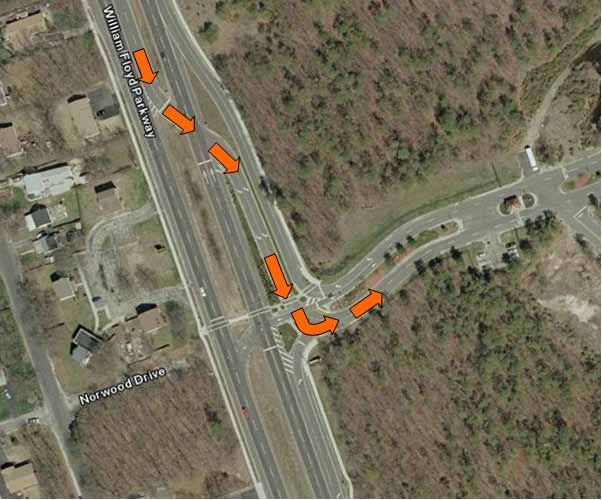
Source: Google TM Earth
Figure 3. Photo. Left-turn crossover movement at a three-legged partial DLT intersection in Shirley, NY.
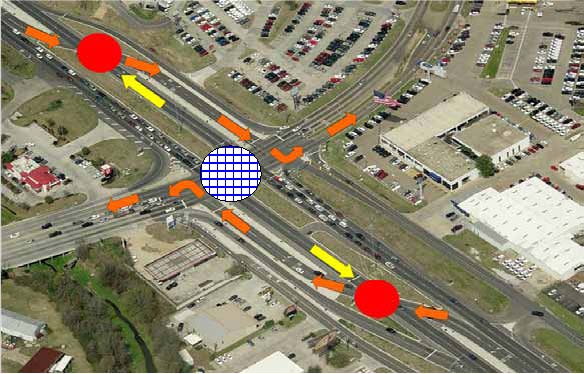
Source: Microsoft ® Windows Local Live
Figure 4. Photo. Left-turn crossover movement at a partial DLT intersection in Baton Rouge, LA.
Figure 4 is a partial DLT intersection where the DLT movements have been implemented on two opposing approaches on the major road in this case. In most cases, the DLTs are on the major roadway. The left-turn movements for the minor road continue to take place at the main intersection. There are three junctions with traffic signal control—the main intersection (shown as the blue hatched circle in figure 4) and the two left-turn crossovers (shown as red circles).
For the full DLT intersection, the left-turn movements are relocated to crossovers on all four approaches, as shown in figure 5. In the figure, the red circle indicates a signal-controlled crossover, the blue hatched circle indicates a signal-controlled main intersection, the orange arrows indicate left-turn crossover movements, and the yellow arrows indicate opposing through movement at a signal-controlled crossover. There are five junctions with traffic signal control at a full DLT intersection—the main intersection (shown as the blue hatched circle) and the four left-turn crossovers (shown as red circles).
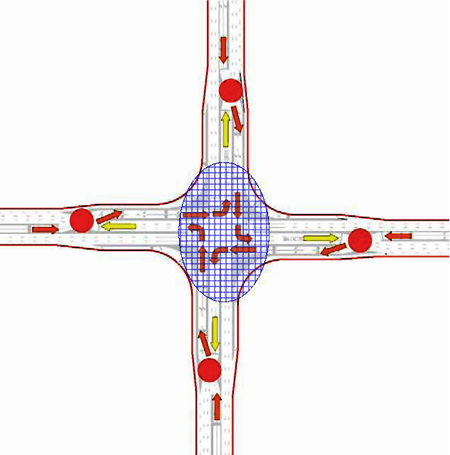
Figure 5. Illustration. Left-turn crossover movements in a full DLT intersection.
Another at-grade variation of the DLT intersection is the parallel flow, which is also known as the paraflow intersection. The parallel flow intersection is described in greater detail in chapter 6. In England, DLT intersections are also known as displaced right-turn intersections. One such intersection was opened in August 2002 in Swindon, UK. (2)
The accommodation of pedestrians at a DLT intersection is an important issue because DLT intersections are suited for urban settings where higher pedestrian activity is likely. Pedestrians crossing at a DLT intersection must cross travel lanes carrying traffic in potentially counterintuitive directions. Depending on pedestrian and traffic volumes, the DLT intersection may not be an appropriate option for some locations due to increased exposure for pedestrian conflicts. For many DLT intersections, pedestrian crossings are possible in multiple signal phases with median islands providing a refuge. This issue is discussed in more detail in section 2.5.
The conversion from a conventional intersection to a DLT intersection offers some advantages over expanding capacity at a conventional intersection or constructing a grade-separated interchange. A DLT intersection is less expensive compared to a grade-separated interchange and can be constructed much faster. (1) In terms of safety, DLT intersections have fewer conflict points compared to conventional intersections. At most volume scenarios, DLT intersections have the potential to considerably reduce average intersection delays. Simultaneous movement of the left-turn and through traffic promotes improved progression of traffic platoons on the arterial and increases vehicular throughput.
A DLT intersection has some disadvantages. Specifically, it has a larger footprint compared to a conventional intersection, which may be a significant factor in the decision not to construct one in an urban area where right-of-way is limited and costly. Access to land parcels located in the quadrants of the intersection can be restricted, and U-turn movements may have to be eliminated at the intersection. (1) In addition, pedestrians cannot cross all four legs as at conventional intersections, and the intersection design can present challenges to pedestrians with visual impairments since the pedestrian paths and some of the traffic movements are not typical. The use of accessible pedestrian signals (APS) is recommended wherever appropriate to better accommodate pedestrians with visual impairments. Unlike a conventional intersection, the DLT intersection has internal conflict points at the left-turn crossover points.
Several DLT intersections have been built in the United States. At the time of this report, DLT intersections are present at the following locations:
- A DLT intersection prototype was constructed as a T-intersection at the intersection of William Floyd Parkway and the entrance of Dowling College National Aviation Technology (NAT) Center in Shirley, NY, in 1995. An aerial view of the intersection was shown previously in figure 3.
- The intersection of Route 210 (Indian Head Highway) and Route 228 (Berry Road) in Accokeek, MD, is also a T-intersection. It operates under traffic signal control and was constructed in 2001. The DLT movement is on the side street approach to the intersection rather than on the major road approach as with the DLT intersection in Shirley, NY. The intersection aerial is shown in figure 6.
- A partial DLT intersection was implemented at the four-legged intersection of U.S. 61 (Airline Highway) at Seigen Lane and South Sherwood Forest Road in Baton Rouge, LA. The DLT intersection was opened in March 2006. The aerial perspective view of this intersection was shown previously in figure 4.
- The intersection of 3500 South and Bangerter Highway in Salt Lake City, UT, was converted in September 2007. It is also a partial DLT intersection with left-turn crossovers on the approaches of Bangerter Highway.
- The latest addition to the list of DLT intersections in the United States is the intersection of U.S. Route 30 and Summit Drive in Fenton, MO, which opened in September 2007. This partial DLT intersection, with left-turn crossovers on the approaches of U.S. Route 30, is shown in figure 7. The figure shows how the DLT intersection can be constructed on the outside of the through lanes and how the existing median width can be preserved without a shift in the through lanes.
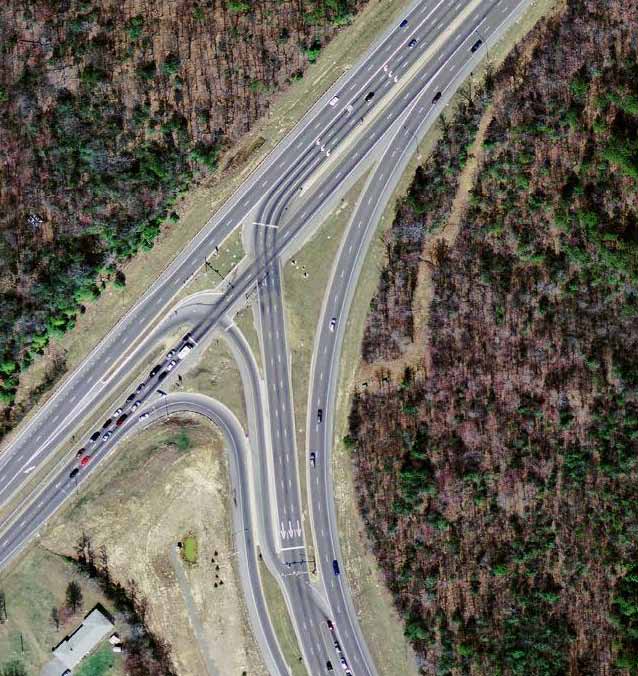
Source: Google TM Maps
Figure 6. Photo. DLT intersection at the intersection of Indian Head Highway (MD 210) and Berry Road (MD 228) in Accokeek, MD.
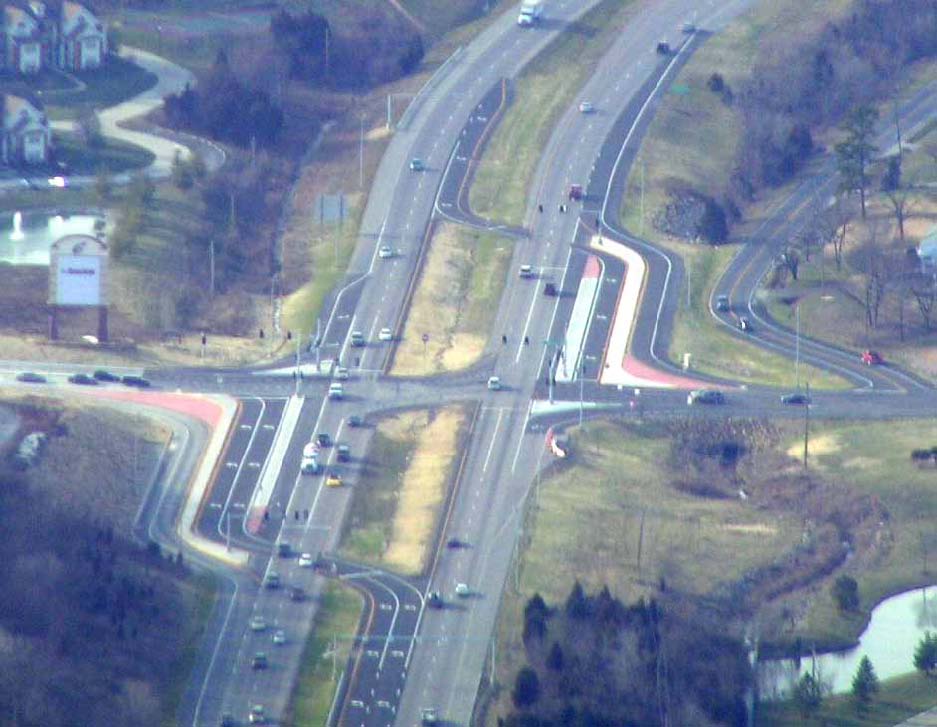
Figure 7. Photo. DLT intersection at the intersection of U.S. Route 30 and Summit Drive in Fenton, MO.
2.2 GEOMETRIC DESIGN CONSIDERATIONS
Figure 8 and figure 9 illustrate typical designs for DLT intersections. The design in figure 8 is for a full version, which has DLT movements on all four approaches. This design reflects a shift of the through traffic lanes into the median in an attempt to minimize the need for additional right-of-way. At several locations where DLT intersections have been implemented as a retrofit to an existing conventional at-grade intersection, the existing median has been preserved, and there is no shift in the through lanes. Figure 9 illustrates a DLT movement at a three-legged intersection with the displacement on the major road.
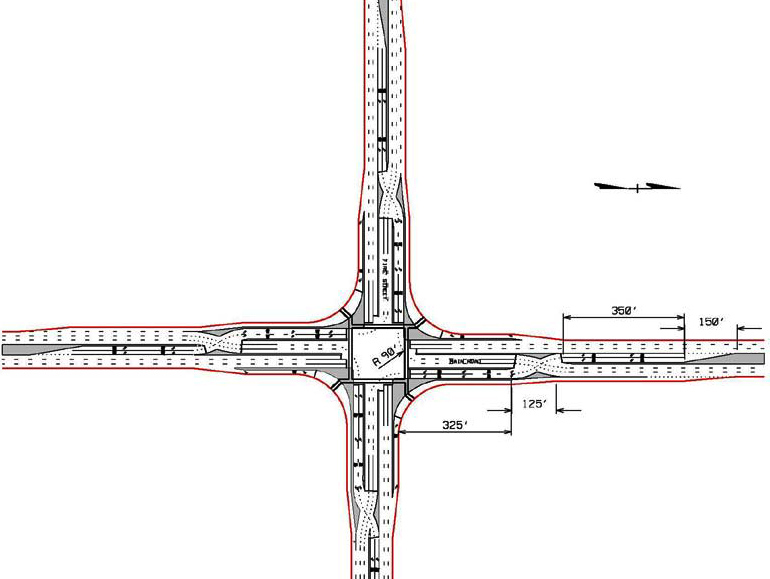
Figure 8. Illustration. Typical full DLT intersection plan view with DLTs on all approaches.
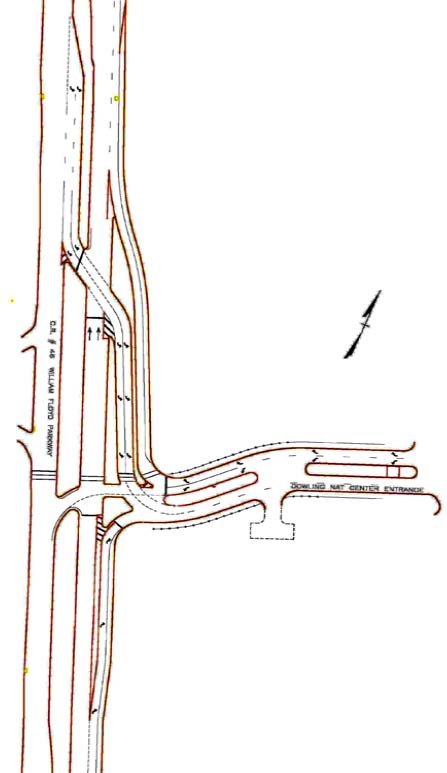
Source: LKM Associates, PC
Figure 9. Illustration. Example of a partial DLT intersection plan view at Dowling NAT Center in Shirley, NY, with DLTs on major road approaches.
Removal of conflict between the left-turn movement and the oncoming traffic at the main intersection is the primary design element in a DLT intersection. (3) The DLT vehicles typically cross the opposing through traffic approximately 300–400 ft upstream of the main intersection under the control of another traffic signal as shown in figure 10 and figure 11. Research performed by the MDSHA shows that the appropriate upstream distance is dependent on queuing from the main intersection and on costs involved in constructing a left-turn storage area for the crossed-over left turn movement. (4) Radii of the crossover movements can range from 150 to 200 ft (see figure 11), while the radius of the next left-turn movement at the main intersection is dependent on the turning movement of the design vehicle. (5) Lane widths at the crossover reverse curve should be wider than 12 ft to accommodate larger design vehicles. Consideration should also be given to having wider lane widths (e.g., up to 15 ft) for the receiving crossroad.
The angle between the DLT intersection left-turn lanes and the main through lanes is referred to as the crossover angle and is influenced by the median width and the alignment of the mainline lanes. The Louisiana Department of Transportation and Development (LA DOTD) recommends an angle of 10–15 degrees. (6)
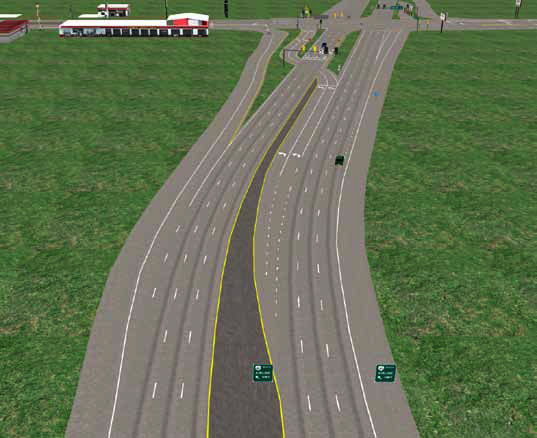
Figure 10. Illustration. Left-turn crossover movement view in a DLT intersection driver simulator.
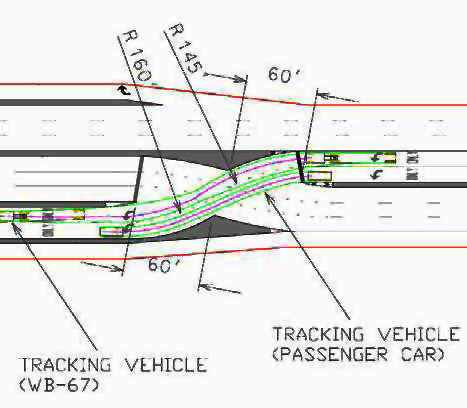
Figure 11. Illustration. Left-turn crossover movement in a DLT intersection.
Right-of-way constraints are an issue common in urban environments. The DLT intersection design helps minimize right-of-way acquisition by occupying far less space compared to grade-separated interchanges. However, due to the presence of left-turn crossovers, a DLT intersection has a larger footprint compared to a conventional at-grade intersection. To minimize the footprint, median widths can be reduced, but they still need to be adequate to accommodate signs. Designers can obtain minimum median widths from the American Association State Highway and Transportation Officials (AASHTO) A Policy on Geometric Design of Highways and Streets, referred to as the Green Book. (7) Designers should also take into account the possibility of installing post-mounted signs in these medians for safe and effective channelization of traffic. Offsets for signs should be in accordance with the Manual of Uniform Traffic Control Devices (MUTCD). (8) A wide median can be counterproductive for several reasons, including the following:
- Wide medians can result in large walking distances for pedestrians at the intersection. This can result in long pedestrian clearance intervals, which can be counterproductive to the efficient signal operation.
- Wide medians resulting in a wide intersection footprint lead to longer yellow and all-red clearance times for the intersection and consequently longer cycle lengths.
If the existing arterial has a wide median, the median can be narrowed through the use of transition curves and guidance from the AASHTO Green Book. (7) Similarly, minimum turning radius criteria for the appropriate design vehicles and shoulder placement can be obtained from the AASHTO Green Book and applied as appropriate. (7) NCHRP Synthesis 225, “Left-Turn Treatments at Intersections—A Synthesis of Highway Practice,” describes several design features for DLT intersections including channelizing islands, overhead lane controls, and raised pavement markers for lane delineation and traffic flow separation. (9)
With the elimination of left-turn movements at the main intersection, U-turns should also be prohibited at the main intersection of a DLT intersection. However, if the median’s width is sufficient, then U-turn movements on the major road can be executed at the left-turn crossover. (10) Designers of the DLT intersection in Baton Rouge, LA, implemented a U-turn crossover with truck restrictions between the main intersection and the left-turn crossover, as depicted in figure 12.
Sight distance and driver expectancy are other issues related to the design of a DLT intersection. Left-turning drivers may be confused when they negotiate the DLT intersection. This can be counterintuitive to unfamiliar drivers. Hence, unambiguous signing is needed.
The DLT intersection in Louisiana was designed and constructed based on the following criteria: (11)
- Design speed of 50 mi/h with 12-ft lanes and 8-ft shoulders on U.S. 61 (Airline Highway).
- Lane width of 12 ft was on all lanes except the frontage roads.
- The median width on U.S. 61 (Airline Highway) was 43 ft.
- Shoulders of 8 ft in width on both sides of U.S. 61.
- The separation between the left-turn crossover and the opposing through traffic was 20 ft.
A 12-ft-wide separation was maintained between the left-turn crossover and the opposing right-turning traffic. Some of the other design guidelines used in the Louisiana DLT intersection were as follows: (11)
- The angle of crossing for DLT vehicles was as great as possible to help reduce the possibility of wrong-way entry and to reduce crossing time.
- Right-turn lanes were provided on intersection legs approaching DLT roadways.
Widening or adding lanes at a DLT intersection in the future could be difficult. Additional lanes that may be needed in the future should be planned during the initial design of a DLT intersection. (11)
2.3 ACCESS MANAGEMENT CONSIDERATIONS
Full DLT intersection implementation typically places restrictions on direct access to parcels situated in the corners of an intersection. Access to these parcels is possible from right-in and right-out configurations. The NCHRP Report 420, “Impacts of Access Management Techniques,” discusses design, location, and spacing of driveways in detail. (12)
As mentioned in the previous section, U-turn movements are prohibited at the main intersection of a DLT intersection. To facilitate egress and easy movement of traffic from driveways in either direction of the approach, U-turn crossovers can be provided between the main intersection and the left-turn crossover. One such U-turn movement using a median opening along with the appropriate signing and marking is shown in figure 12 and was implemented in Baton Rouge, LA. Median width at the U-turn crossover should be sufficient to facilitate U-turning of the design vehicle.
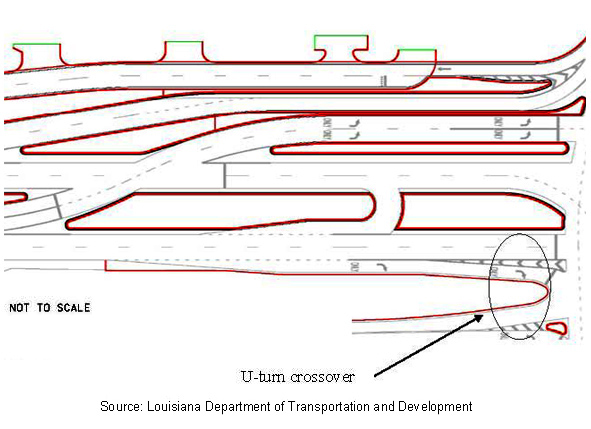
Figure 12. Illustration. Location of U-turn at DLT intersection in Baton Rouge, LA.
Since direct access to adjacent businesses is restricted in a DLT intersection design, the use of frontage roads can provide access to these businesses. General features of frontage roads and their typical layouts are detailed in the AASHTO Green Book. (7) Outer separation should be maintained per the AASHTO Green Book recommendations. (7)
Chapter 10 of the NCHRP Report 420 also discusses application guidelines for one-way and two-way frontage roads and their key features. (12) Figure 13 shows the frontage road design at the DLT intersection in Baton Rouge, LA. According to designers of the Louisiana DLT intersection, two-way frontage roads might be required in some quadrants to provide local access to business sites in the quadrant. (6)
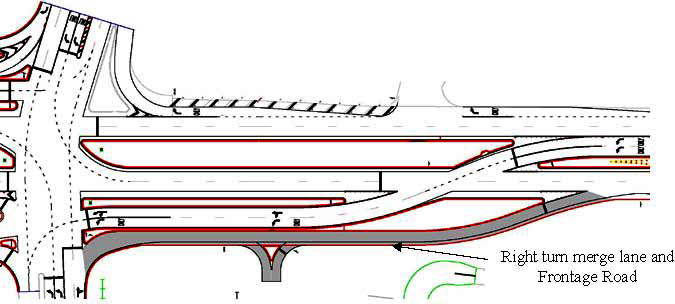
Figure 13. Illustration. Right-turn merge lane/frontage road at DLT intersection in
Baton Rouge, LA.
With restricted access to parcels located close to the main intersection, the optimal placement of driveway openings in the vicinity of a DLT intersection is an important issue. Approaches at the DLT intersection that have the left-turn crossovers cannot accommodate median breaks typically within a distance of 600–700 ft of the main intersection depending on the design of the left-turn crossovers. Therefore, driveways on the approaches to the main intersection need to be right-in and right-out only.
Driveway widths, other dimensions, and sight distance requirements can be determined using local and national design guidelines, such as the AASHTO Green Book. (7) Other potentially applicable design guidance can be found in the Institute of Transportation Engineers (ITE) Guidelines for Driveway Location and Design. (13) Figure 13 through figure 15 show the location of one such driveway at the DLT intersection in Baton Rouge, LA, with a channelizing “porkchop” island and driveway signing.
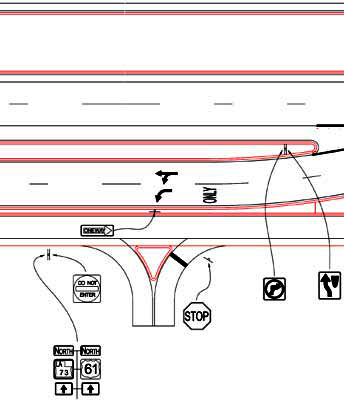
Source: Louisiana Department of Transportation and Development
Figure 14. Illustration. Location of driveway and signage at the DLT intersection in
Baton Rouge, LA.
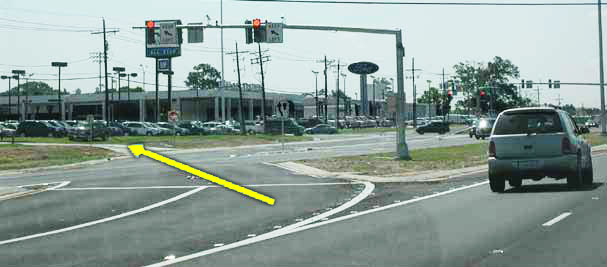
Figure 15. Photo. Right-in, right-out driveway accessible via the right-turn merge lane/frontage road at the DLT intersection in Baton Rouge, LA.
2.4 TRAFFIC SIGNALIZATION TREATMENTS
A DLT intersection has traffic signal control at the main intersection and the left-turn crossovers, as shown in figure 16. At a full DLT intersection with left-turn crossovers on all four approaches, the signal control for each of the five locations operates each location as two-phase signal-controlled intersections. Since there are only two signal phases, optimal cycle lengths are typically between 60 and 90 s. At a partial DLT intersection that handles minor road left turns at the main intersection, the signal control at the main intersection operates with three signal phases and cycle lengths typically between 80 and 110 s. When multiple signal controllers are used at a DLT intersection to control each signalized intersection separately, coordination of the traffic signal controllers is necessary.
DLT intersections have shorter cycle lengths because of the reduced number of phases. Therefore, if a DLT intersection exists within a corridor and if the cycle lengths for the other intersections in the system are different from the cycle length for the DLT intersection, then the DLT intersection is operated as an isolated intersection. However, if the cycle length of the DLT intersection is the same as or half of the signal cycle length of the other intersections in the system, then progression is achieved. The DLT intersection design also has to consider the progression on an arterial, which is done by preserving the background cycle and a guaranteed green time during that cycle for the major street. Depending on the specific turning movement volumes and geometry, it is possible to establish timings that result in the following:
- Reductions in delay for the through vehicles.
- Reductions in delay for vehicles waiting to turn left.
- Reductions in delay for drivers of vehicles who have entered the DLT lane and are traveling toward the main intersection to eventually turn left.
- Reductions in delay for drivers of vehicles who have turned left and are traveling to the final crossing on the through approach.
- Reductions in the number of stops for all vehicles.
- Increase in efficiency for pedestrian crossings on all intersection legs.
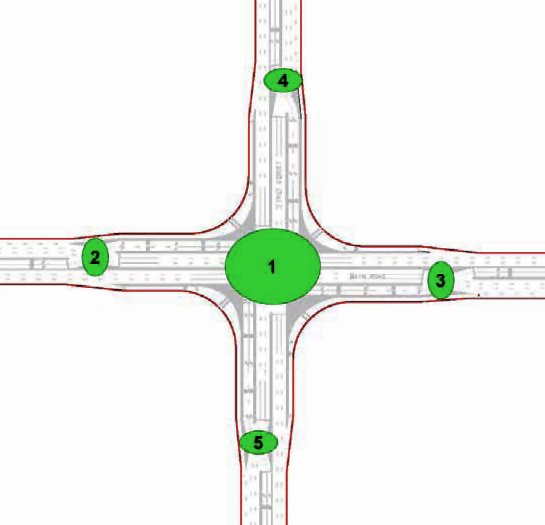
Figure 16. Illustration. Typical DLT intersection signal locations.
2.4.1 Signal Design
Since DLT intersections are appropriate for intersections with high through and left-turning volumes, signals are likely warranted both at the main intersection and the left-turn crossovers. Figure 16 shows the typical location of the signals at the main intersection and the left-turn crossovers. The green circles in the figure indicate typical signal locations.
Signal control at a DLT intersection may be operated in a fully actuated mode to minimize delay. Detectors can be installed to cover all of the crossovers, the minor street approaches, and the major street approaches. The five signals, as shown earlier in the full DLT intersection, can be operated either with separate controllers or with a single controller. The signal phasing for a DLT intersection where five separate signal controllers are used is depicted in figure 17. The signal phasing for a DLT intersection where one signal controller is used is depicted in figure 18. The signal phasing scheme for the partial DLT intersection is shown in figure 19.
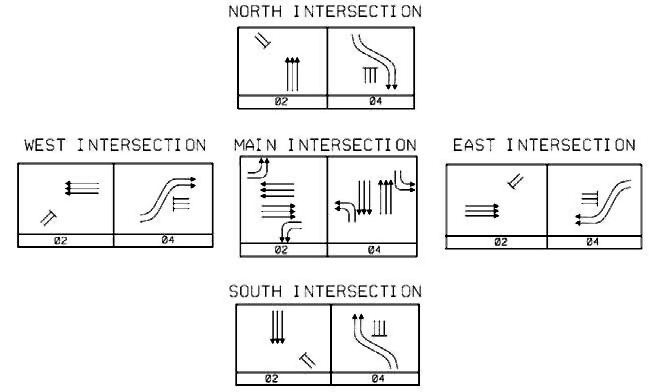
Figure 17. Illustration. Two-phase signal phasing at the five separately controlled signalized intersections within a full DLT intersection.

Figure 18. Illustration. Signal phasing for a full DLT intersection with a single controller.
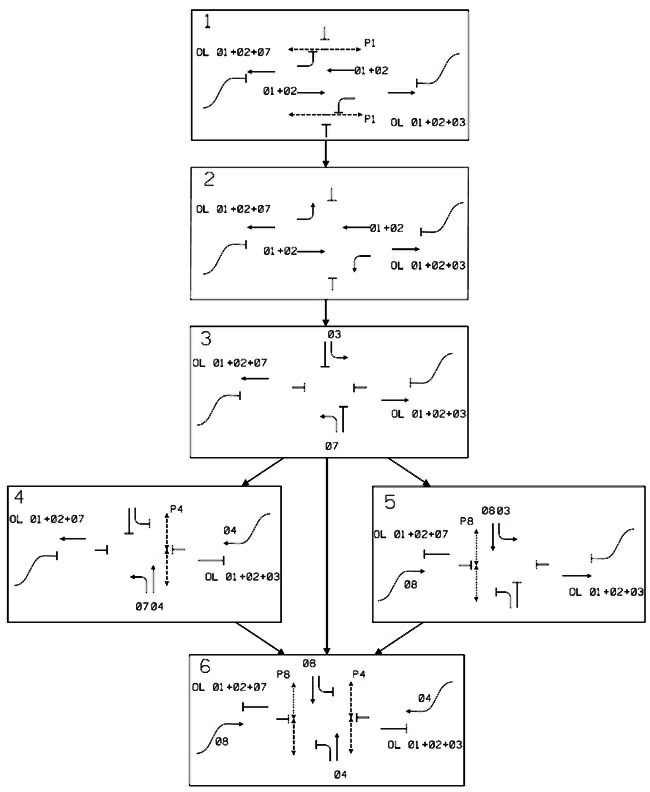
Figure 19. Illustration. Signal phasing for a partial DLT intersection
Figure 20 is a schematic of suggested signal pole and mast arm locations in a box layout scheme for a full DLT intersection. One possible set of locations for pedestrian push-buttons is depicted in figure 20, and the reader is referred to section 4E.08 of MUTCD for further information. (8) Figure 21 shows an alternative strategy that was used for an existing DLT intersection at the junction of William Floyd Parkway and the entrance of Dowling NAT Center in Shirley, NY. It is a span wire system with pedestal poles located on one of the median islands for pedestrian push-buttons. Detectors were not installed for the right-turn movements or for the opposing through movement at the left-turn crossover. Figure 22 shows the suggested typical signal pole and mast arm locations in a box layout scheme for a partial DLT intersection.
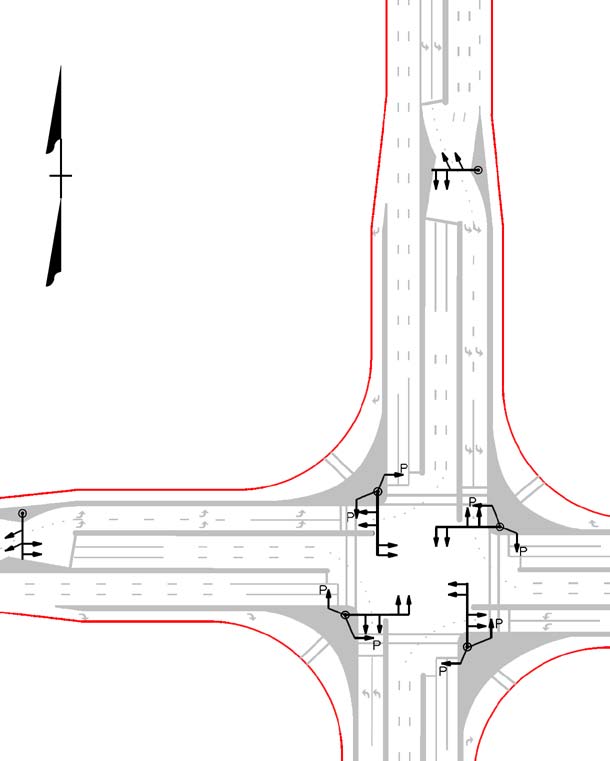
Figure 20. Illustration. Conceptual box layout signal pole and mast arm locations for a DLT intersection.
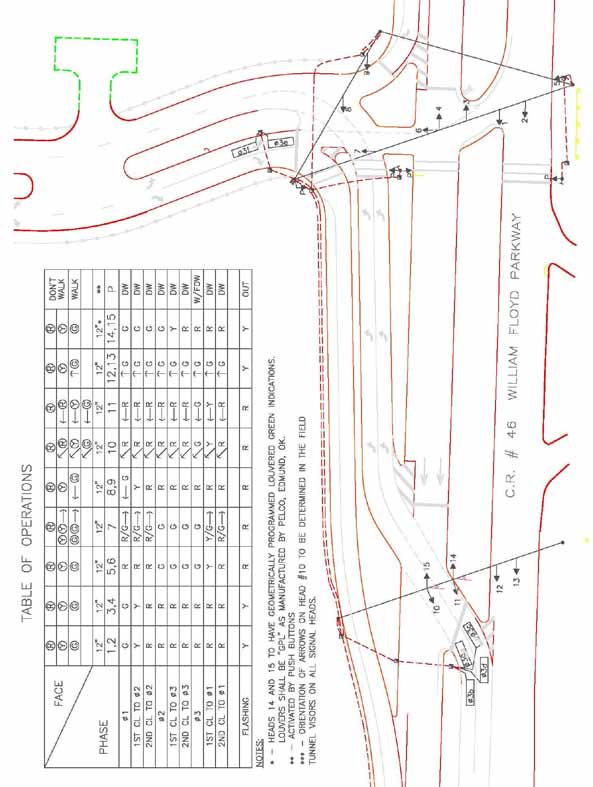
Source: LKM Associates, PC
Figure 21. Illustration. Existing span wire system at entrance of Dowling NAT Center in Shirley, NY.
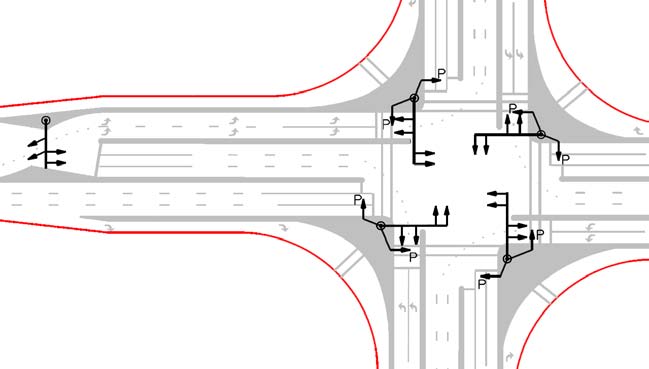
Figure 22. Illustration. Conceptual box layout signal pole and mast arm locations for DLT intersection.
Detector actuation depends on the type of operation. Figure 23 and figure 24 show the possible in-pavement, loop detector placement for multiple controllers and single controller for a full DLT intersection, respectively. Figure 25 shows the possible placement and detection technique for a partial DLT intersection. The DLT intersection at the intersection of U.S. Route 30 and Summit Drive uses video detection technology. An angular arrow signal display, as shown in figure 26, can be used to direct traffic at the left-turn crossovers.
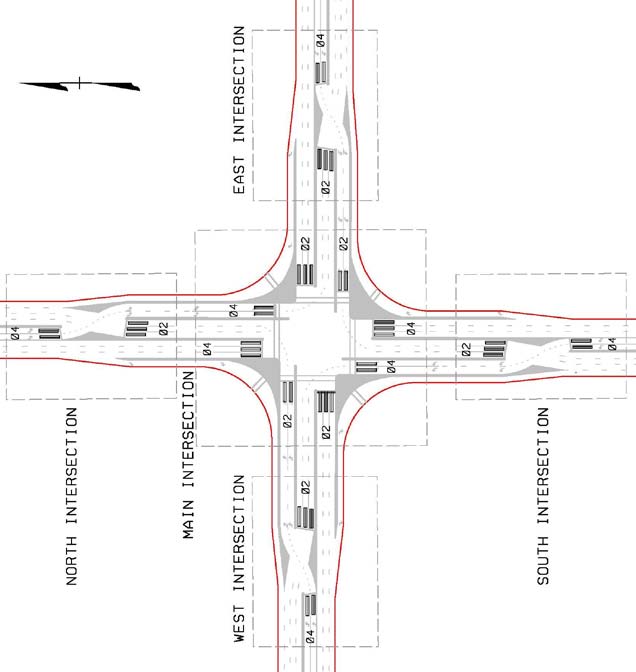
Figure 23. Illustration. Possible detector placement locations
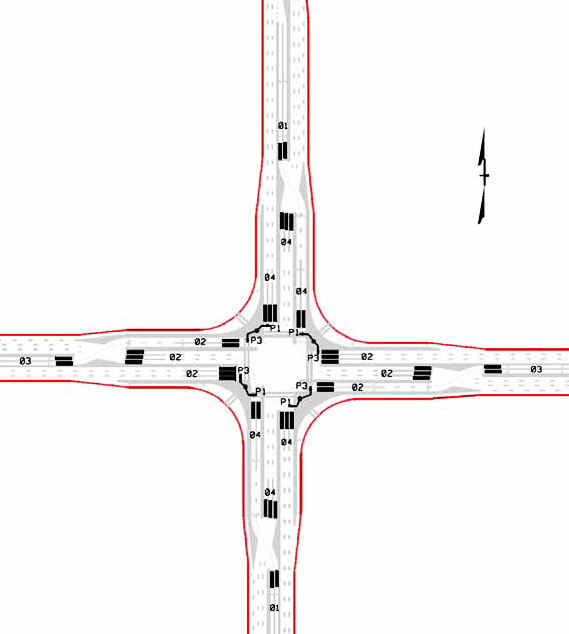
Figure 24. Illustration. Possible detector placement locations for a full DLT intersection
with a single controller.

Figure 25. Illustration. Possible detector placement locations for a partial DLT intersection.
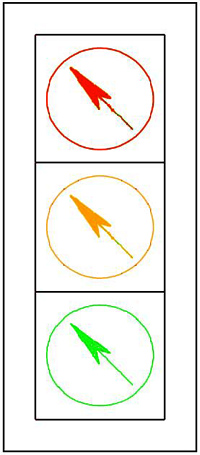
Figure 26. Illustration. Angular arrow signal display.
The geometry of the DLT intersection is different from a conventional intersection. The signal control at the main intersection typically operates as a two-phase signal with short cycle lengths conducive to good progression. Therefore, pedestrians cross the intersection in multiple crossing stages. (2) Existing literature describes alternative pedestrian signal strategies including clockwise and counterclockwise optimization of pedestrian flows at a DLT intersection. (14)
Typically, the crosswalks across the channelized right-turning roadways are installed without pedestrian push-buttons. The push-buttons for pedestrians to cross the major legs of the intersection are located on the channelizing islands which also serve as pedestrian refuges.
Figure 27 through figure 30 show various perspectives of the signal and mast arm locations at the DLT intersection in Accokeek, MD.
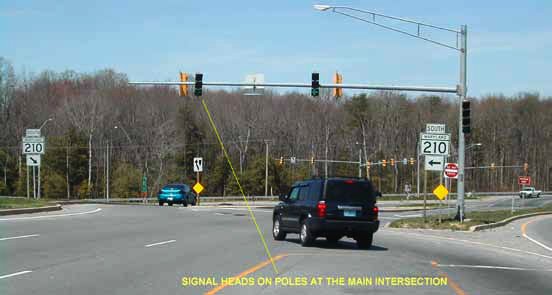
Figure 27. Photo. Signal pole locations at the cross junction at the intersection of MD 210 at MD 228 in Accokeek, MD.
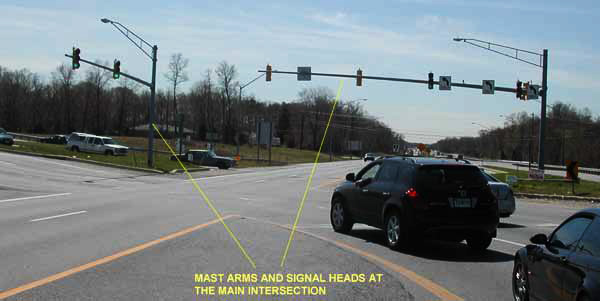
Figure 28. Photo. Signal pole locations at the main intersection of MD 210 at MD 228 in Accokeek, MD.
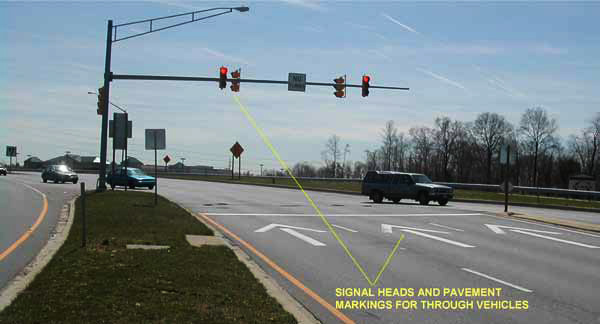
Figure 29. Photo. Signal pole locations at the intersection of MD 210 at MD 228 in Accokeek, MD.
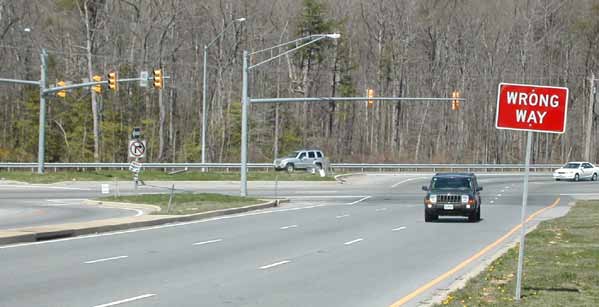
Figure 30. Photo. Signal pole locations at the main intersection viewed from the minor street approach.
2.4.2 Signing and Marking
Signing and marking at a DLT intersection can be significantly different compared to a conventional intersection, particularly related to the midblock left-turn crossovers and the turning restrictions at the main intersection. Emphasis must be given to wrong-way pavement markings and signing to warn drivers of turn prohibitions. Overhead signing and post mounted signing are the primary methods of guidance. Pavement markings and overhead lane use signs on signal mast arms are the supplementary method of guidance.
Figure 31 shows the signing and marking plan based on MDSHA guidance for one direction of travel only on a main street and a side street approach. Figure 32 shows the existing signing and marking as it was implemented at the DLT intersection in Baton Rouge, LA, consisting of several right-in and right-out turning restrictions at driveways.
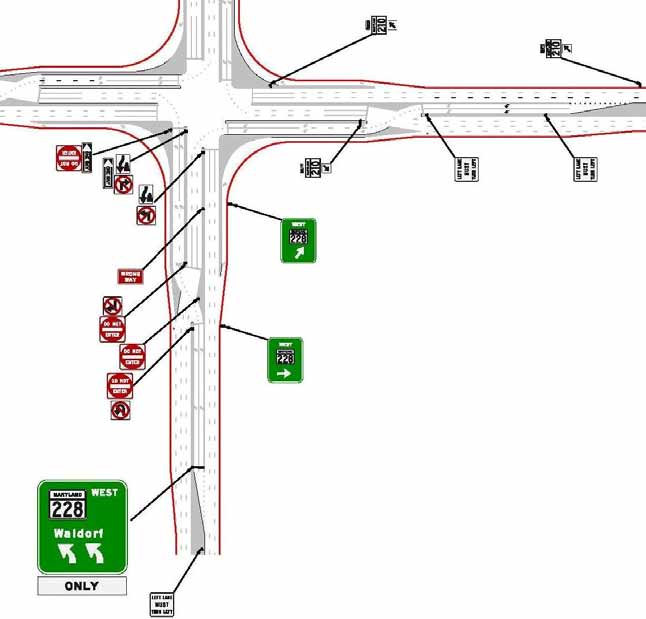
Figure 31. Illustration. DLT intersection signing and marking plan derived from
Maryland practice.
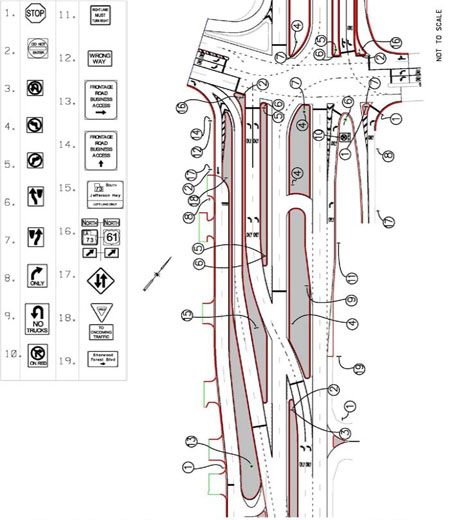
Figure 32. Illustration. Ground-mounted signing and marking as used at the DLT intersecion in Baton Rouge, LA.
Photographs of overhead signing and pavement markings that are present at the DLT intersection in Baton Rouge, LA, are shown in figure 33 through figure 35.
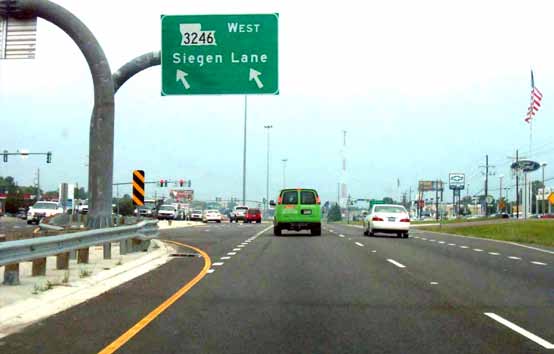
Figure 33. Photo. Overhead signing at the DLT intersection in Baton Rouge, LA.(11)
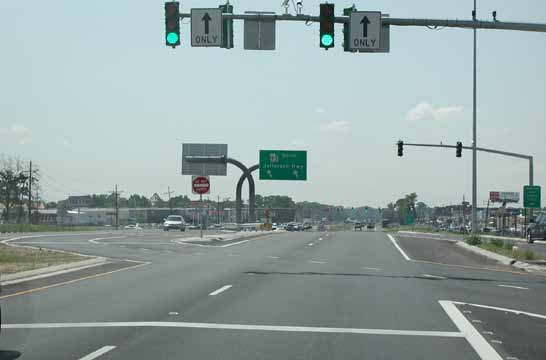
Figure 34. Photo. DLT overhead signing at DLT intersection in Baton Rouge, LA.(11)
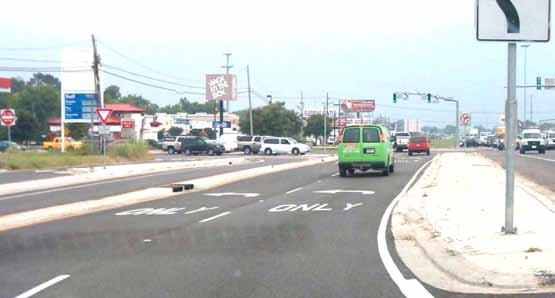
Figure 35. Photo. Pavement markings on the displaced left-turn lanes at DLT intersection in Baton Rouge, LA.(11)
2.5 ACCOMMODATION OF PEDESTRIANS, BICYCLISTS, AND TRANSIT USERS
Pedestrian movements at a DLT intersection are typically accommodated as shown in figure 36. The locations of pedestrian paths are depicted in figure 36 as well. At a DLT intersection, the position of the left-turn lanes between the opposing through lanes and right-turn lanes can be counterintuitive to pedestrians. In addition, the wide geometric footprint of the DLT intersection combined with short signal cycle lengths can accommodate pedestrian crossing efficiently. Median islands, if available, can provide pedestrian refuge.
Figure 36 shows the pedestrian crossing paths between the four quadrants. Crossing the street diagonally (for example, between quadrant A and D) requires pedestrians to cross two streets. The crossing procedure is as follows:
- The pedestrian must cross a channelized right-turn roadway to a pedestrian refuge island.
- The pedestrian then crosses the first street that offers a “Walk” signal (either the side street or main street to quadrants B or C) to the pedestrian refuge island on the opposite side. The pedestrian crosses the through lanes and left-turn lanes of the street.
- The pedestrian crosses the second street (to A or D) by crossing the through lanes and left-turn lanes to the diagonally opposite pedestrian refuge island.
- The pedestrian completes the crossing procedure by crossing a right-turning roadway.
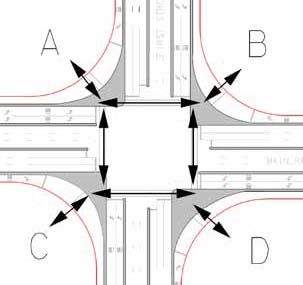
Figure 36. Illustration. Possible pedestrian movements at a DLT intersection.
The method of crossing a DLT intersection is similar to a traditional intersection design. Several measures, as described in the following paragraphs, should be considered to increase pedestrian safety.
2.5.1 Provide Pedestrian Refuges Between Opposing Through Lanes to Increase Pedestrian Safety and Minimize Vehicular Delay
Crosswalks can be installed across all four legs. If pedestrian crossing times cause long vehicular delays, multiple-stage crossings could be facilitated at a DLT intersection by providing pedestrian refuges in a median between the opposing through lanes of an approach.
2.5.2 Provide Wayfinding Signing for Pedestrians
Signing to facilitate pedestrian wayfinding can help direct pedestrians through the intersection and to desired destinations. Providing adequate wayfinding signing is important given that most pedestrians initially are unfamiliar with the designated crossing patterns of a DLT intersection design. Adequate signing helps reduce pedestrian confusion and may encourage pedestrians to use designated travel paths through the intersection.
2.5.3 Design Right-Turn Channelized Islands to Accommodate Pedestrians
Right-turn channelizing islands can enhance pedestrian safety by allowing pedestrians to cross a right-turn lane separately using the channelized island for refuge. However, this could also create potential hazards for pedestrians if the island is designed to favor the movement of vehicles as follows:
- A wide turn radius.
- A flat entry angle leaving the right turn.
- Wide lanes.
Configuring the right-turn lane with a tighter radius and narrower lanes can help reduce the speed of turning vehicles and provide better visibility for drivers of crossing pedestrians. The right-turn lane can also operate under traffic signal control. This improves the overall safety for pedestrians and reduces crossing distance.
2.5.4 Provide Accessible Devices to Assist Disabled Pedestrians
Pedestrians with vision and cognitive impairments may find crossing a DLT intersection challenging. Pedestrians with cognitive impairments may have trouble differentiating the presence of left-turn lanes from opposing through and right-turn lanes. With this in mind, locator tones can be used at the pedestrian signals, and specialized surface treatments on ramps can be located at the quadrants and median refuges to assist with differentiation. APS are recommended as well. Readers are directed to the American with Disabilities Act Accessibility Guidelines (specifically sections 4 and 10 on accessible elements and spaces and transportation facilities, respectively), available on the U.S. Access Board’s Web site for extensive information on accommodating visually impaired pedestrians. (15)
Results of previous research indicate that overall pedestrian flow at a DLT intersection is improved greatly with shorter signal cycle lengths. (14) Pedestrian crosswalks, as implemented at the DLT intersection at the entrance of Dowling NAT Center in Shirley, NY, are shown in figure 37.
With the unusual geometry, the DLT intersection may cause several problems after its initial opening to users familiar with the conventional four-leg intersection. Public information distributed prior to opening of a DLT intersection treatment can help alleviate concerns and raise citizens’ understanding and awareness of this design. Public information for pedestrians and bicyclists was disseminated with the help of flyers before the scheduled opening of the DLT intersection in Salt Lake City, UT.
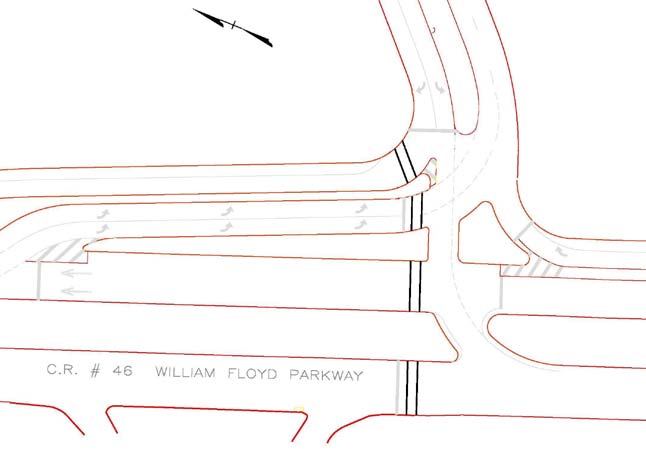
Source: LKM Associates, PC
Figure 37. Illustration. Pedestrian crosswalks as implemented at DLT
Bicyclists can be accommodated on the street in a DLT intersection. Off-roadway bicycle paths or shared-use paths can be accommodated if they are designed to cross at appropriate locations at the DLT intersection (e.g., at stoplines where conflicting traffic movements enter). Typical locations of a shared-use path crossing would be the same as the locations of crosswalks as previously depicted in figure 36.
Transit and school buses operating through a DLT intersection may be challenged when serving passengers in the immediate intersection area. For the most part, bus stops need to be located relatively far from the crosswalks at the intersection, either upstream of left-turn crossovers or downstream of the intersection beyond the crossover for the opposing direction. Figure 38 shows the potential location of a transit stop for one approach of a DLT intersection. More detail on bus stops follows:
- Bus stops upstream of an intersection approach that do not have a left-turn crossover are not affected.
- For existing at-grade intersections with bus stops along the route, retrofitting the intersection with a DLT intersection may result in the relocation of bus stops to locations
upstream or downstream on approaches with crossovers, which affects buses making left turns at the intersection.
- For bus routes proceeding straight on the mainline, the right-turn lane upstream of the intersection can be used as the bus stop.
- For bus routes turning right on an approach, the right-turn lane or the right-turn acceleration lane can be used as the bus stop. This requires designing the right-turn lane to accommodate pedestrians (discussed earlier in this section) because passengers often proceed from the stop to the intersection to cross and would be crossing the right-turn lane. Since the bus stop has the potential to temporarily impede right-turning traffic, a pullout may be appropriate. The pullout can be located in the acceleration lane downstream of the right turn.
A disadvantage to locating transit stops further from the pedestrian crossing points at the intersection is that passengers are more likely to cross the street at the bus stop than if the stop is closer to the intersection. Crossing at a midblock, unprotected location presents hazards to pedestrians at any type of intersection. However, at a DLT intersection, it is possible that the midblock location may be through the paths of left-turning vehicles approaching the crossover (as in shown in figure 38). Pedestrians walking through vehicles queued at the crossover would not be expected by approaching through traffic, and the pedestrian’s view of approaching through traffic could be obstructed by taller vehicles in the left-turn queue. Installing a barrier in the median would discourage pedestrians from crossing midblock.
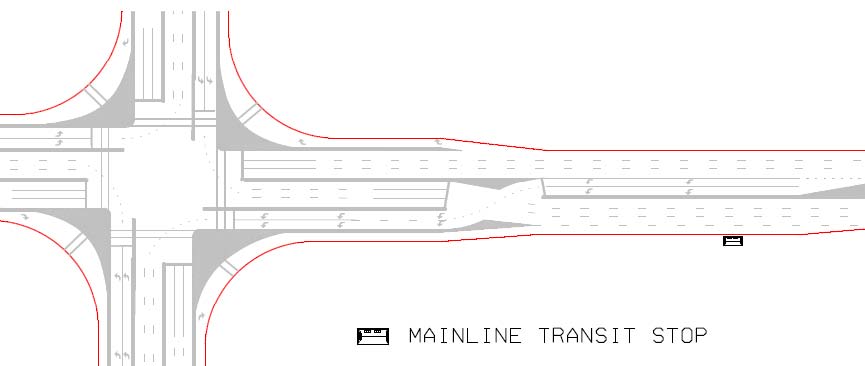
Figure 38. Illustration. Possible transit stop location in a DLT intersection.
2.6 OPERATIONAL PERFORMANCE
This section discusses the situations in which a DLT intersection can be expected to have improved performance over a conventional intersection. The discussion is based on a review of research on the DLT intersection and also on results of simulation studies of the intersection design.
2.6.1 Review of Previous Research
Several studies have examined the operational and other benefits of the DLT intersection. For highly unbalanced left-turn and through volumes on the DLT approaches or when the overall intersection volumes were low, the conventional intersection outperformed the DLT intersection. However, when the left-turn and through volumes on the DLT approaches volumes were high and balanced, the DLT intersection was found to operate better than the conventional intersection. (14) A summary of the benefits identified by the studies is presented below, grouped by category.
2.6.1.1 Capacity
Two studies published in 1994 concluded that with high volumes of conflicting movements, the DLT intersection was greatly superior to the conventional intersection, and the advantages of a DLT intersection over a conventional intersection were most pronounced when the traffic demand approached or exceeded the capacity of conventional designs and when heavy left-turn movements required protected phases. (15,3) The 1996 Traffic Control Systems Handbook cited a study comparing the performance of traffic operations at a DLT intersection with that of operations at a similar conventional intersection. (17) The study indicated a 60 percent increase in capacity at the DLT intersection. Another report referred to the DLT intersection as the dispersed movement intersection (DMI) and concluded that this type of intersection “can provide comparable capacity at a fraction of the cost of a grade separation.” (18) The report also mentioned that the DLT intersection increased capacity without compromising safety. A 2001 report stated that the displaced right-turn junction (in Great Britain) was a multinode intersection which improved overall junction capacity through the removal of conflicts at the center of the intersection. (2)
A 1974 study in Great Britain examining right-turn capacity (equivalent to left turns in the United States) found an increase in right-turn capacity and a reduction in delay, especially at high right-turn volumes. (19) A 1994 study showed that the capacity of the upstream signalized crossover was approximately twice that of the turning volume of a conventional intersection with similar geometry and balanced traffic volumes. (15)
2.6.1.2 Travel Time, Delay, and Speed
In 1974, Hutchinson noted that “the results clearly support the claims of Al Salman and Salter, showing a great increase in capacity for right-turners (Great Britain) and a corresponding reduction in delay, particularly at high flows for right-turners.” (19) The Traffic Control Systems Handbook reported that a study had found significant increases in average speed for the DLT intersection. (17) In 1998, Reid and Hummer compared unconventional intersections to their conventional counterparts and suggested that “the displaced left-turn intersection always had the highest move-to-total-time-ratio of all designs.” (20)
Other benefits noted by the Traffic Control Systems Handbook were substantial reductions in auto emissions for the DLT intersection. (17) Reid and Hummer also suggested that “the displaced left-turn intersection probably needs the smallest right-of-way of all the unconventional designs (quadrant roadway intersection, median U-turn, super street median, bowtie, jug-handle, split intersection and displaced left-turn intersection)” that they examined. (20)
2.6.2 Analysis of Simulation Results
VISSIM ® , a microscopic traffic simulation software, was used to gain insights into the operational performance of a DLT intersection in comparison to conventional intersections. Four intersection geometric scenarios of DLT intersections and conventional intersections were simulated. Table 2 shows the geometric design configurations of the cases simulated. The lane configurations and geometric features of the DLT intersections and conventional intersections on the approaches of the major roads and the minor roads were identical for each case. These four geometric cases with three major road directional splits were simulated under three sets of traffic volumes: low, medium, and high. The major and minor road splits were set at 50 percent each for all simulation cases. Therefore, a total of 16 unique sets of simulation conditions were developed for the DLT intersection, and an equal number of unique VISSIM ® simulations were developed for comparable conventional intersections (see figure 3). The VISSIM ® simulation network was 1 mi long on the major and minor road approaches for the cases simulated. The base case simulations assumed no pedestrian activity at the intersection. A discussion of the simulation results for all of the geometric design cases is provided in this section. In addition to the use of typical VISSIM ® defaults, the following constants were maintained for each simulation:
- Optimum fixed signal timing determined using Synchro ®. (21)
- Yellow times determined using ITE policy.
- All-red times determined using ITE policy.
- A total of 5 percent heavy vehicles on all legs.
- A total of 350-ft left-turn bay lengths upstream of the displaced crossover junction.
- A total of 325-ft left-turn bay lengths downstream of the displaced crossover junction.
- A network size of 0.5 mi in each direction from the main intersection.
- Single right-turn bays on the mainline.
- Right turn on red allowed at each signal. No left turn on red allowed.
- A signal at each displaced left-turn crossover.
- A 40-ft median width on mainline.
- Undivided side street.
- A 45 mi/h desired speed on mainline.
- A 25 mi/h desired speed on side street.
- Saturation headway of approximately 1,900 vehicles per hour per lane (veh/h/lane).
- No bus stops.
- Seeding time of 30 minutes for the simulations.
- Running period of 60 minutes for the simulations.
The four cases modeled were as follows:
- Intersection of a six-lane major road and a six-lane minor road with four corresponding DLTs (one on each approach).
- Intersection of a six-lane major road and a four-lane minor road with only two opposing DLTs (one on each approach of the major road).
- Intersection of a six-lane major road and a four-lane minor T-leg with the DLTs on the major road.
- Intersection of a four-lane major road and a four-lane minor road with only two opposing DLTs (one on each approach of the major road).
Table 2. Geometric design configuration for VISSIM ® simulation. Table 3. Volumes for geometric design configuration for VISSIM ® simulation—full DLT intersection.
| Geometric Design Cases |
Approach Configuration |
| Major Road |
Minor Road |
| DLT intersection and Conventional Intersection |
| Through Lanes |
Left-Turn Lanes |
Right-Turn Lanes |
Through Lanes |
Left-Turn Lanes |
Right-Turn Lanes |
| A |
3 |
2 |
1 |
3 |
2 |
1 |
| B |
3 |
2 |
1 |
2 |
1 |
1 |
| C |
3 |
2 |
1 |
2 |
2 |
1 |
| D |
2 |
1 |
1 |
2 |
1 |
1 |
Table 3. Volumes for geometric design configuration for VISSIM® simulation—full DLT
intersection.
| Geometric Cases |
Turning Movement Volume Set (veh/h) |
Major Road Approach 1 Volume* (veh/h) |
Major Road Approach 2 Volume* (veh/h) |
Total Minor Road Volume** (veh/h) |
Major Road Approach 1 Volume/Total Major Road Volume (veh/h) |
Total Minor Road Volume/Total Intersection Volume (veh/h) |
| A |
Three-lane major road, two left-turn lanes on major road, and three-lane minor road approaches |
1 |
1,000 |
1,000 |
1,000 |
0.50 |
0.33 |
| 2 |
1,750 |
1,750 |
1,500 |
0.50 |
0.30 |
| 3 |
2,500 |
2,500 |
2,000 |
0.50 |
0.29 |
| 4 |
3,500 |
3,500 |
7,000 |
0.50 |
0.50 |
| 5 |
3,500 |
1,500 |
7,000 |
0.70 |
0.58 |
| B |
Three-lane major road, two left-turn lanes on major road, and two-lane minor road approaches |
1 |
750 |
750 |
500 |
0.50 |
0.25 |
| 2 |
1,500 |
1,500 |
1,500 |
0.50 |
0.33 |
| 3 |
2,750 |
2,750 |
3,500 |
0.50 |
0.39 |
| 4 |
3,000 |
3,000 |
4,000 |
0.50 |
0.40 |
| 5 |
3,000 |
1,286 |
4,000 |
0.70 |
0.48 |
| C |
Three-lane major road, one left-turn lane on major road, and two-lane minor road approaches |
1 |
1,000 |
1,000 |
500 |
0.50 |
0.20 |
| 2 |
1,750 |
1,750 |
2,000 |
0.50 |
0.36 |
| 3 |
2,500 |
2,500 |
3,000 |
0.50 |
0.38 |
| 4 |
2,500 |
1,071 |
3,000 |
0.70 |
0.46 |
| D |
Three-lane major road, two left-turn lanes on major road, and two-lane minor road approaches |
1 |
750 |
750 |
500 |
0.50 |
0.25 |
| 2 |
1,500 |
1,500 |
1,500 |
0.50 |
0.33 |
| 3 |
2,500 |
2,500 |
1,500 |
0.50 |
0.23 |
| 4 |
3,000 |
3,000 |
4,000 |
0.50 |
0.40 |
| 5 |
3,000 |
1,286 |
4,000 |
0.70 |
0.48 |
* A constant right-turn volume of 300 has been used and is excluded from the major road volumes shown. ** Both minor road approaches have the same volumes.
2.6.3 Geometric Design Case A Simulation
The DLT intersection simulated for this design case had three through lanes, two left-turn lanes, and one right-turn lane per approach for all four approaches. The DLT lane before the main intersection had a length of 325 ft, the right-turn bay had a length of 250 ft, and the left-turn bay before the separation of the DLT had a length of 350 ft. All acceleration lanes for right-turning vehicles were 300 ft long. The median separating the opposing through lanes was 10 ft wide, the median separating the through lanes from the DLT lanes was 10 ft wide, and the median separating the through lanes from the right-turn lane was 6 ft wide. The comparable conventional intersection had similar geometric features and dimensions as the DLT intersection described above on all four approaches.
The traffic flows on the approaches of the DLT intersection were randomly generated. A large number of cases modeled had directional flows to replicate peak hour directional flows at intersections. The total cycle length for all scenarios was 70 s. The ranges in traffic volumes used for each approach by movement were as follows:
- Left-turn movement: 100–750 veh/h.
- Through traffic movement: 300–2,650 veh/h.
- Right-turn movement: 50–350 veh/h.
The results for the full DLT intersection are summarized in figure 39. In addition, a partial DLT intersection was also evaluated. The results are shown in figure 40.
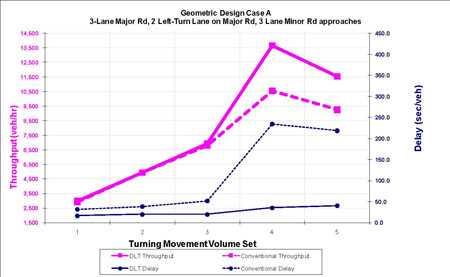
Figure 39. Graph. Throughput and delay comparison for geometric design case A-full DLT Intersection.
Geometric Design Case A 3-Lane Major Rd, 2 Left-Turn Lane on Major Rd, 3 Lane Minor Rd approaches Turning Movement Volume Set
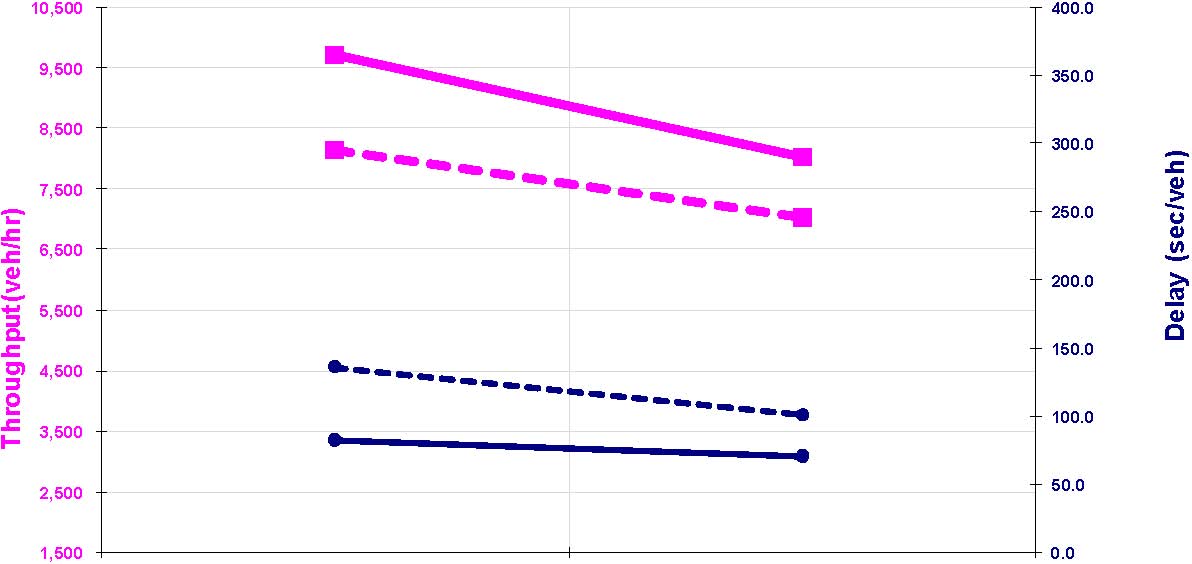

Figure 40. Graph. Throughput and delay comparisons for partial DLT intersection geometric design case A.
2.6.4 Geometric Design Case B Simulation
The intersection had three through lanes, two-left-turn lanes, and one right-turn lane per approach for the two major road approaches. The DLT lane before the main intersection had a length of 325 ft, the right-turn bay had a length of 275 ft, and the left-turn bay before the separation of the DLT had a length of 350 ft. The acceleration lanes for the right-turning vehicles were 300 ft in length. The two minor road approaches were configured as a conventional geometric design with two through lanes, one left-turn lane, and one right-turn lane. For the minor road approaches, the length of the right-turn bay was 3 ft, and the left-turn bay was 350 ft. The median separating the opposing through lanes was 10 ft wide, the median separating the through lanes from the DLT lanes was 10 ft wide, and the median separating the through lanes from the right-turn lane was 6 ft wide. The comparable conventional intersection had similar geometric features and dimensions as the DLT intersection described above on all four approaches.
The traffic flows on all the approaches were randomly generated. A large number of cases modeled had directional flows to replicate peak hour directional flows at intersections. The cycle length used for all scenarios was 80 s.
The ranges of traffic volumes used for each approach by movement were as follows:
- Major road left turns: 100–700 veh/h.
- Major road through traffic: 300–2,200 veh/h.
- Major road right turns: 50–350 veh/h.
- Minor road left turns: 50–200 veh/h.
- Minor road through traffic: 50–1,200 veh/h.
- Minor road right turns: 50–250 veh/h.
The results for a full DLT intersection for case B are shown in figure 41. The results for a partial DLT intersection for case B are shown in figure 42.
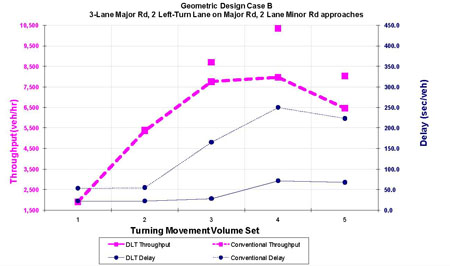
Figure 41. Graph. Throughput and delay comparison for geometric design case B-full DLT intersection.
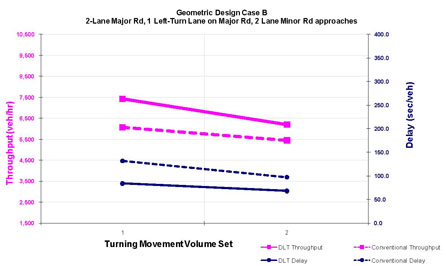
Figure 42. Graph. Throughput and delay comparison for partila DLT Intersection geometric design case B.
2.6.5 Geometric Design Case C Simulation
Case C modeled a T-intersection. There were three through lanes per direction on the major road with DLT lanes on one major road approach and one right-turn lane on the other major road approach. The minor road approach had two left-turn lanes and one right-turn lane (see figure 8). The DLT lane before the main intersection had a length of 325 ft, the right-turn bay on the major road had a length of 300 ft, and the left-turn bay before the separation of the DLT had a length of 350 ft. The acceleration lane for the right-turning vehicles was 300 ft long. The minor road approach had a conventional geometric design with two left-turn lanes and one right-turn lane. The length of the left-turn bay on the minor approach was 350 ft. The median separating the opposing through lanes was 10 ft wide, and the median separating the through lanes from the right-turn lane was 6 ft wide. The geometry could be further improved if a separate acceleration lane was provided for the right-turning vehicles from the main road. The comparable conventional intersection had similar geometric features and dimensions as the DLT intersection described above on all three approaches.
The traffic flows on all approaches were randomly generated. A large number of cases modeled had directional flows to replicate peak hour directional flows at intersections. The cycle length for all scenarios was 70 s.
The ranges of traffic volumes used for each approach by movement were as follows:
- Major road left turns: 50–750 veh/h.
- Major road through traffic: 300–2,650 veh/h.
- Major road right turns: 50–350 veh/h.
- Minor road left turns: 100–1,450 veh/h.
- Minor road right turns: 50–750 veh/h.
The results are shown in figure 43.
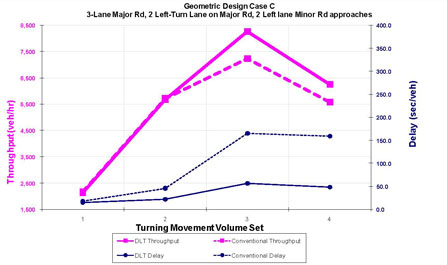
Figure 43. Graph. Throughput and delay comparisons for geometric design case C.
2.6.6 Geometric Design Case D Simulation
The intersection model had two through lanes, one left-turn lane, and one right-turn lane per approach for the two major roads. The DLT lane before the main intersection had a length of 325 ft, the right-turn bay had a length of 275 ft, and the left-turn bay before the separation of the DLT had a length of 350 ft. The acceleration lanes for the right-turning vehicles were 300 ft long. The two minor road approaches had a conventional geometric design with two through lanes, one left-turn lane, and one right-turn lane. For the minor road approaches, the length of the right-turn bay was 300 ft, and the left-turn bay was 350 ft. The median separating the opposing through lanes was 10 ft wide, the median separating the through lanes from the DLT lane was 10 ft wide, and the median separating the through lanes from the right-turn lane was 6 ft wide.
The comparable conventional intersection had similar geometric features and dimensions as the DLT intersection described above on all four approaches.
The traffic flows on all the approaches were randomly generated. A large number of cases modeled had directional flows to replicate peak hour directional flows at intersections. The cycle length used for all scenarios was 80 s.
The ranges of traffic volumes used for each approach by movement were as follows:
- Major road left turns: 100–350 veh/h.
- Major road through traffic: 300–1,500 veh/h.
- Major road right turns: 50–350 veh/h.
- Minor road left turns: 50–200 veh/h.
- Minor road through traffic: 50–1,200 veh/h.
- Minor road right turns: 50–250 veh/h.
The results are shown in figure 44.
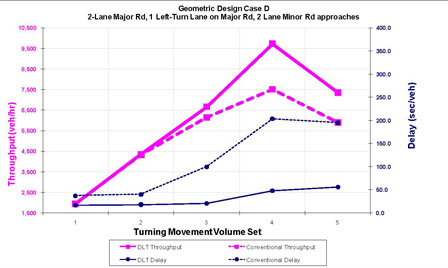
Figure 44. Graph. Throughpu and delays comparisons for geometric design case D.
2.6.7 Discussion of Simulation Results
For each of the cases modeled, the DLT intersection consistently outperformed the conventional intersection with respect to vehicle throughput, vehicle delay, number of stops, and queue length. The average vehicle delay and queue estimation models can help traffic engineers and planners compare the DLT intersection with other types of intersections to measure suitability of application, especially when traffic congestion at the intersection is a serious problem. The results of the operational analysis are summarized below.
The operational improvement of the DLT intersection over the conventional intersection was notable even at relatively low traffic volumes, but greater benefits were achieved with the DLT intersection design as traffic volumes increased. The reduction in number of phases for those approaches with the DLT intersection significantly reduced vehicle delay and increased the capacity of the intersection considerably. In addition, the percent reduction in average intersection delay for a DLT intersection compared to a conventional intersection is shown for each simulated case when mainline flows were balanced as follows:
- Case A: 48–85 percent.
- Case B: 58–71 percent.
- Case C: 19–90 percent.
- Case D: 54–78 percent.
The percent reduction in average intersection delay for a DLT intersection compared to a conventional intersection is shown for each simulated case when mainline flows were unbalanced as follows:
- Case A: 82 percent.
- Case B: 70 percent.
- Case C: 69 percent.
- Case D: 72 percent.
The percent reduction in average intersection delay for the partial DLT intersection compared to a conventional intersection is shown for each simulated case when mainline flows were balanced as follows:
- Case A: 39 percent.
- Case B: 36 percent.
The percent reduction in average intersection delay for the partial DLT intersection compared to a conventional intersection is shown for each simulated case when mainline flows were unbalanced as follows:
- Case A: 30 percent.
- Case B: 30 percent.
The percent reduction in the average number of stops for the DLT intersection compared to a conventional intersection was 15–30 percent for nonsaturated traffic flows at the conventional intersection and 85–95 percent for saturated traffic flow conditions at the conventional intersection.
The percent reduction in average intersection queue length for a DLT intersection compared to a conventional intersection is shown for each simulated case as follows:
- Case A: 62–88 percent.
- Case B: 66–88 percent.
- Case C: 34–82 percent.
- Case D: 64–86 percent.
The percent increase in throughput of the intersection for a DLT intersection compared to a conventional intersection is shown for each simulated case when mainline flows were balanced as follows:
- Case A: 30 percent.
- Case B: 30 percent.
- Case C: 16 percent.
- Case D: 30 percent.
The percent increase in throughput of the intersection for a DLT intersection compared to a conventional intersection is shown for each simulated case when mainline flows were unbalanced as follows:
- Case A: 25 percent.
- Case B: 25 percent.
- Case C: 12 percent.
- Case D: 25 percent.
The percent increase in throughput of the intersection for the partial DLT intersection compared to a conventional intersection is shown for each simulated case when mainline flows were balanced as follows:
- Case A: 20 percent.
- Case B: 20 percent.
The percent increase in throughput of the intersection for a partial DLT intersection compared to a conventional intersection is shown for each simulated case when mainline flows were unbalanced as follows:
- Case A: 14 percent.
- Case B: 10 percent.
It is important to note that all cases had signal timings adjusted for pedestrian presence. In the absence of pedestrians, cycle lengths were lowered, resulting in average intersection delay in the range of 14–19 s/veh at low and medium traffic volumes for case A.
Even with a single signal timing, the DLT intersection worked effectively for all combinations of traffic flows (low, medium, and heavy). This is unique and can be useful for intersections that cannot implement multiple signal timing plans.
2.7 SAFETY PERFORMANCE
Because relatively few DLT intersections existed when this report was developed, very limited data were available to evaluate the safety performance of DLT intersections. Based on the design and operation of the intersection, however, it is possible for a DLT intersection to offer safety advantages over a conventional intersection. Figure 45 shows the conflict points of a partial DLT intersection with left-turn crossovers present on the mainline approaches. The total number of conflict points in this case is 30 compared to the 32 conflict points at a conventional intersection. Figure 46 shows the conflict points of a full DLT intersection with left-turn crossovers present on all approaches. The total number of conflict points in this case is 28. The slightly lower number of conflict points could translate to fewer collisions.
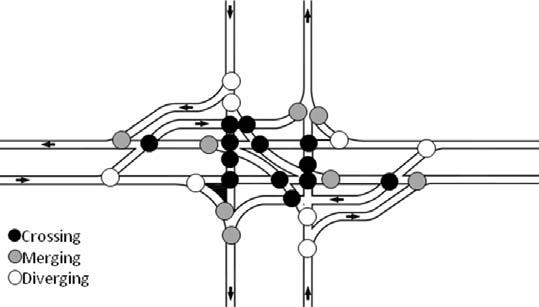
Figure 45. Illustration. Conflict point diagram for a partial DLT intersection.
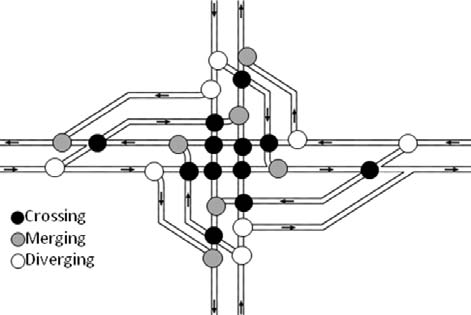
Figure 46. Illustration. Conflict point diagram for a full DLT intersection.
A possible safety disadvantage is related to unfamiliar drivers and older drivers. There are several counterintuitive design features of the DLT intersection, which were discussed previously. These features could result in driver confusion in the following ways:
- Drivers are familiar with making left-turn maneuvers at the main intersection. In the case of a DLT intersection, the indirect left turn occurs several hundred feet ahead of the main intersection. Even with adequate signage, this requires drivers to anticipate the left turn in advance of the main intersection, which may be counterintuitive. (22)
- The design features of a DLT intersection and the relocation of turn movements at the main intersection can lead to wrong-way movements. Wrong-way movements can be reduced by providing adequate signage and pavement markings. (22)
One DLT intersection was examined to determine the extent of driver discomfort with the nontraditional intersection. Dowling College sponsored a human factors study of the DLT intersection in Shirley, NY, to determine how the design affected the driving task. (23) The study found that “about 80 percent of the first time users of the DMI intersection expressed positive comments about the design.” (23) According to the study, “after about a week of use, 100 percent of the daily drivers sampled expressed positive comments about the design.” (23) The study concluded that “the intersection is easily negotiated by drivers who are initially unfamiliar with the design and that after a short learning period, nearly all drivers are familiar and comfortable with the DMI intersection.” (23) The DLT intersection at the Dowling NAT Center was implemented with the construction of a new entrance for Dowling College. Hence, there is no before period for which intersection crash statistics can be collected for this DLT intersection.
The DLT intersection at the intersection of Airline Highway and Seigen Lane in Baton Rouge, LA, was opened for operation in March 2006. A total of 4 years of before data (2002 to 2005) and 2 years of after data (2006 to 2008) were obtained to conduct a simple before-after crash comparison. Table 4 shows a summary of the results for total crashes as well as fatal and injury crashes. Based on a simple before-after comparison, total crashes per year were reduced by 24 percent, while severe crashes (i.e., fatal and injury) were reduced by almost 19 percent after the installation of the DLT intersection. In addition, total crash rates decreased by almost 24 percent, and severe crash rates decreased by 22 percent. While the study only included 2 years of after data and did not account for changes in other factors (e.g., traffic volumes, time trends, etc.), the initial results are encouraging.
Table 4. Annual averages collision rates for DLT intersection at Airline Highway an d
Seigen Lane in Louisiana.
| Year |
Number of Reported Collisions by Severity |
All Reported Crash Rate (Per Million Entering Vehicles on Major Road) |
Fatal and Injury Crash Rate (Entering Vehicles on Major Road) |
| Total |
Fatal and Injury |
| Annual average before (2002–2005) |
147 |
37 |
5.09* |
1.26* |
| Annual average after (June 2006–May 2008) |
111 |
30 |
3.87** |
0.98* |
| Difference after minus before (percent difference) |
-36 (-24.4%) |
-7 (-18.9%) |
-1.22 (-23.9%) |
-0.28 (-22.2%) |
* Average annual daily traffic (AADT)s for years 2003 and 2004 were interpolated. ** AADT for year 2006 was interpolated.
2.8 CONSTRUCTION COSTS
The cost of constructing a DLT intersection is likely to be higher than that of a conventional intersection mainly due to increased footprint and possible additional right-of-way requirements. Assuming that the required right-of-way is available, the additional construction costs of a DLT intersection are relatively small compared to a conventional intersection with similar design characteristics. These costs are related to the additional grading and paving as well as additional pavement markings, signing, and signals.
The presence of left-turn crossovers for a DLT intersection requires a larger footprint compared to a similar conventional intersection (see figure 47). Assuming left-turn crossovers on all four approaches, the DLT intersection has a footprint that is almost one acre larger than a conventional intersection. The increased footprint increases the right-of-way costs if additional land needs to be acquired. The cost of right-of-way may vary substantially from $10 to $100 per square foot and may be a major factor in deciding not to install a DLT intersection.
Aside from right-of-way, the cost of additional traffic signal control is likely to be higher. The typical cost for a new signal installation is approximately $200,000. A DLT intersection has signal control at the main intersection similar to conventional intersection; however, it also requires a signal control at each left-turn crossover, which is upstream of the main intersection. For a full DLT intersection with four left-turn crossovers, the cost for traffic control can be substantially higher compared to a conventional intersection.
The cost of three completed DLT intersection projects are provided to give a perspective of the total cost for a DLT intersection project as follows:
- The recent construction of a DLT intersection in Baton Rouge, LA, involved construction of left-turn crossovers, a frontage road, widening, and channelization work. No additional right-of-way was required for this project. Construction work included grading, drainage structures, lime treatment, base course, Superpave ® concrete, Portland cement concrete pavement, traffic signalization, lighting, and other related work. The total bid price was approximately $4.4 million. This cost included $1 million for frontage road development that was required to mitigate the loss of access to businesses. (6)
- The DLT intersection at the intersection of Bangerter Highway and 3500 South in Salt Lake City, UT, opened prior to the completion of this report. Preliminary press releases indicated that the total cost of the project was $7.5 million. (24)
- The DLT intersection at the intersection of U.S. Route 30 and Summit Drive in Fenton, MO, had a total construction cost of $4.5 million.
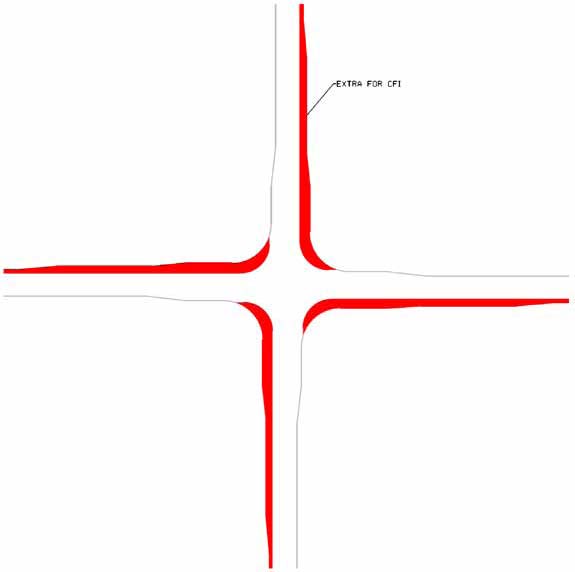
Figure 47. Illustration. Footprint comparison of a DLT intersection versus a
conventional intersection.
An ideal comparison of costs and benefits consists of final construction plans for conventional intersection improvements, a DLT intersection, and other alternatives including grade-separated interchanges along with an evaluation of operational and safety performance. Operational and safety performance may be valued differently depending on the project. The potential operational and other benefits of the DLT intersection were presented in previous sections and compared to similar conventional intersection designs. The actual monetary benefits related to the operational and safety performance of a DLT intersection should be based on the individual project. This section presents a comparison of DLT intersection construction costs versus conventional intersection construction costs. Though highway agencies may be considering a DLT intersection at a location where an intersection already exists and may be weighing grade-separated options along with the DLT intersection, a comparison to conventional intersection costs is presented here since the physical construction will be most similar to a DLT intersection.
Table 5 provides a detailed construction cost comparison of a conventional intersection and a full DLT intersection. For this comparison, certain assumptions are made to simplify the process. It is assumed that additional right-of-way is available and not purchased, which is indicative of an implementation at a rural site. It is also assumed that mobilization, overhead lighting, pavement marking, and drainage costs are not significantly different between the two types of intersections. Lastly, it is assumed that no special grading or construction features, such as retaining walls, are required. Unit cost prices were obtained from the RS Means Heavy Construction Cost Book. (25)
Table 5. New DLT intersection construction cost estimates.
| # |
Item |
Unit |
Unit Cost ($) |
DLT Intersection |
Equivalent Conventional Intersection |
| Quantity |
Total Cost ($) |
Quantity |
Total Cost ($) |
| 1 |
Mobilization (assumed to be the same for all) |
LS |
N/A |
N/A |
N/A |
N/A |
N/A |
| 2 |
Earthwork • Site prep, excavation, etc. |
CY |
12.47 |
36,880 |
460,000 |
31,720 |
396,000 |
| 3 |
Pavement • Surface (2 inches). • Base (6 inches). • Sub-base (8 inches). |
SY SY SY |
6.93 15.50 10.80 |
54,890 54,890 54,890 |
380,000 851,000 593,000 |
50,370 50,370 50,370 |
349,000 781,000 544,000 |
| 3 |
Curb and gutter Concrete islands/raised medians (8-inch cement concrete pavement) |
LF SF |
11.10 37.50 |
25,270 22,970 |
280,000 861,000 |
15,850 12,850 |
176,000 482,000 |
| 4 |
Drainage (assumed to be the same for all) |
N/A |
N/A |
N/A |
N/A |
N/A |
N/A |
| 5 |
Traffic control devices • A new signal is assumed to be $200,000. Equipment required for a CFI is approximately two times more than that of a conventional intersection and consequently priced at $300,000. |
EA |
200,000 |
2 |
400,000 |
1 |
200,000 |
| 6 |
Utilities (assumed to be the same for all) |
N/A |
N/A |
N/A |
N/A |
N/A |
N/A |
| 7 |
ADA requirements • Ramps: 5 inches wide. • Concrete sidewalk. |
LF LF |
450 14.42 |
80 8,240 |
36,000 119,000 |
20 8,420 |
9,000 121,000 |
| 8 |
Pavement markings (assumed to be the same for all) |
N/A |
N/A |
N/A |
N/A |
N/A |
N/A |
| |
Total |
3,980,000 |
|
3,058,000 |
N/A = Not applicable.
Based on the assumptions for this example, the total cost of a DLT intersection in a rural area is approximately $922,000 more than a conventional intersection. The significant contributing factors to the increased costs are earthwork, materials, and additional signals. While the increase in construction costs may be substantial (nearly 30 percent), there are several conditions that may warrant the increase. For example, as Goldblatt and Mier concluded, “if the traffic conditions are severe, or if there are considerations of such techniques as grade separation, then the DLT intersection design might be the optimal solution.” (3) In addition, one-, two-, or three-legged DLT intersection designs may be constructed as appropriate to improve safety and operations while minimizing costs.
2.9 CONSTRUCTION SEQUENCING
Constructing a DLT intersection at an existing conventional intersection presents several challenges related to the maintenance of traffic and protection of road users and workers. This section presents construction sequencing options for consideration during the construction of DLT intersections. Work zone traffic control plans were obtained for the construction of DLT intersections in Louisiana and Utah and are described below.
2.9.1 Sequence of Construction for DLT intersection in Baton Rouge, LA
The sequence of construction for the intersection of Airline Highway and Siegen Lane in Baton Rouge, LA, was obtained from the LA DOTD. An aerial photo of this intersection was shown previously in figure 8. For the purposes of this phasing sequence example, the north-south roadway is referred to as the major road where left-turn crossovers were installed. The east-west roadway is the minor road, and the approaches were constructed in a manner similar to a conventional intersection. There were three phases of construction, which are discussed below.
Phase I included the following:
- Installation of temporary signal heads, poles, and new controllers at the main intersection, the minor intersection with frontage road, and the left-turn crossovers. (During phase II, installation of fiber optic interconnect cable for new signal system was also initiated.)
- Construction of frontage roads for DLT intersection lanes, new driveways along frontage roads, and turnouts.
- Construction of right-turn lanes along major roads, left-turn lanes along major roads, right-turn lane for a frontage road in southeast quadrant, and crossovers.
- Placement of permanent striping on the southwest frontage road. Temporary traffic signals operated on a new controller.
Phase II included the following:
- Installation of new signal poles at the main intersection, the minor intersection with a frontage road, and the left-turn crossovers. New signal heads on mast arms remain covered until placed in operation.
- Installation of permanent signing, high mast pole lighting, temporary striping for right-turn lanes along major roads (northbound), and temporary striping for turnouts.
- Construction of island on the service road and its temporary striping and signal heads.
- Construction of left-turn lanes along the median edge of major roads (northbound), right-turn lanes on the minor roads (eastbound), and left-turn DLT intersection lanes on the major roads (northbound).
Phase III included the following:
- Placement of permanent signals and removal of temporary signal systems at the main intersections.
- Installation of temporary striping on DLT intersection lanes.
- Removal of left-turn lanes and the construction of islands in the median of major roads between the two left-turn crossovers.
- Completion of islands at main intersections and remaining wearing course and permanent striping.
2.9.2 Sequence of Construction for DLT intersection in Salt Lake City, UT
Work on the DLT intersection in Salt Lake City, UT, began in March 2007, and the intersection was opened to the public on September 16, 2007. A portion of the construction sequence was obtained from the Utah Department of Transportation (UDOT) Web site and is shown as follows:
2.9.2.1 Winter 2007
- Work began on the northeast and southwest corners of the intersection.
- The first noticeable traffic impact was the closure of right lanes in each direction near the intersection.
- Crews placed construction fencing, cleared two developments on adjacent sites, and removed a section of the sound barrier wall.
- Some excavation and utilities work took place.
2.9.2.2 Spring 2007
- Excavation and utility work continued.
- Crews began concrete work and paving.
2.9.2.3 Summer 2007
- Crews completed concrete work and paving.
- New signals were installed.
Construction work was completed at this intersection by closing it off completely and utilizing the existing network to detour traffic. Detour signs were placed according to typical designs and were located 350 ft ahead of the upstream intersection. Figure 48 and figure 49 illustrate the detour routes as well as detour signing used during the work.
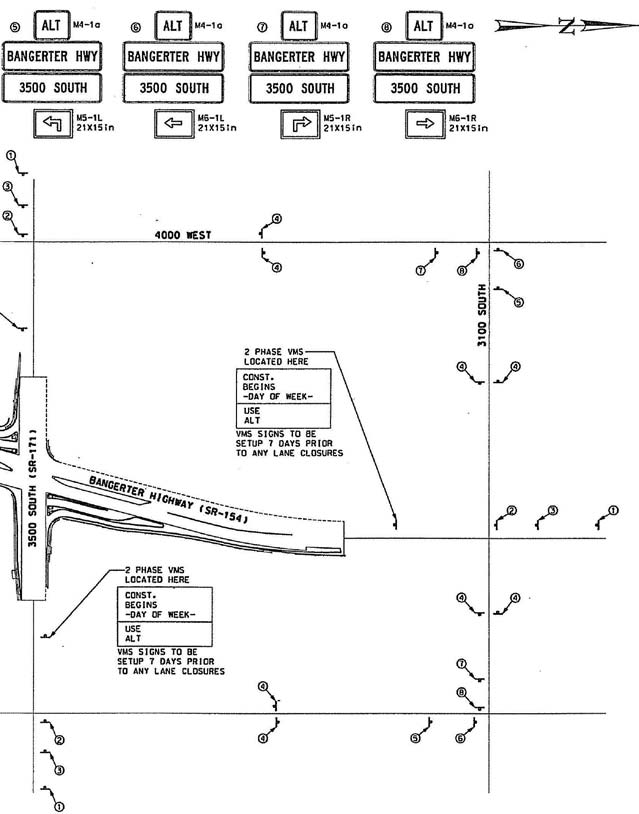
Figure 48. Illustration. Detour routes for construction of a DLT intersection in Salt Lake City, UT—north end.
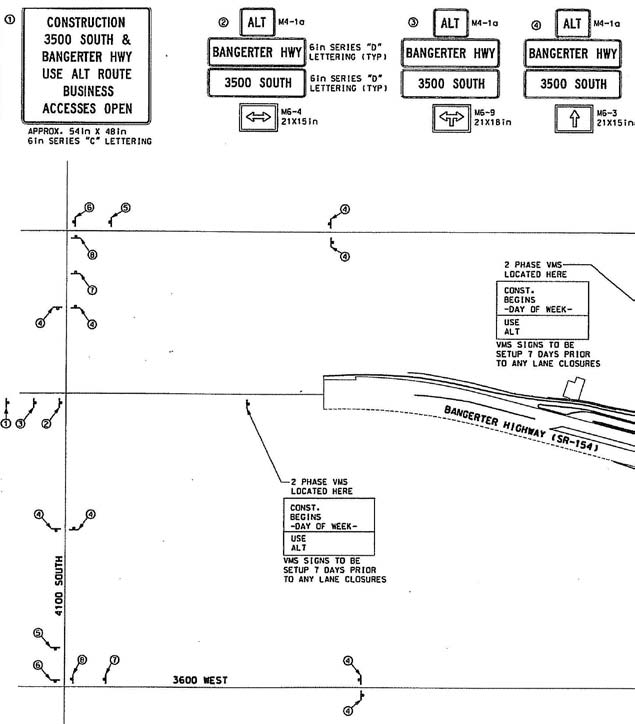
Figure 49. Illustration. Detour routes for construction of DLT intersection in Salt Lake City, UT—south end.
2.10 OTHER CONSIDERATIONS
In addition to topics previously presented, there are other factors to note when considering a DLT intersection design. Possible complications that may arise after construction include possible blockage of the crossover during traffic incidents or accidents, emergency response challenges, loss of power to the traffic signals, as well as the need for taller light poles, public involvement, and traffic law enforcement.
The presence of a left-turn crossover in a DLT intersection results in conflicting internal movements. This creates a potential for the crossover to be blocked during traffic accidents or incidents where stoppage of one movement (either the left-turn crossover or the through vehicles) could block the other movement. These situations can be mitigated by construction of shoulders or a bypass roadway to move vehicles around the blockage. In addition, metering and signal coordination with upstream and downstream intersections can help control traffic flow. (22) For the DLT intersection in Louisiana, backup batteries and a natural gas generator were provided in the traffic signal system in case of power failures. In addition, six to eight law enforcement personnel were considered in the event of a failure of the backup power system. (6)
Blockage is a significant issue for emergency response; however, there are other characteristics of a DLT intersection that create issues for emergency response. With the presence of left-turn crossovers and the alternating direction of vehicle movements on an approach, the DLT intersection design creates restrictions on access for emergency vehicles. The DLT intersection design should allow for emergency vehicle access in the event of an accident or disabled vehicle. The use of mountable curbs in the crossover area could help facilitate emergency vehicle access to the crossover area. In addition, frontage roads could also provide access in an emergency. Agencies should also consider appropriate response procedures for the removal of disabled vehicles from the area, including the crossovers and the main intersection.
A full DLT intersection with left-turn crossovers on all approaches has five signalized junctions. Loss of power and signal malfunctions are causes for concern because manual traffic control using police officers is not a viable option for the safe and efficient operation of five signalized junctions. Therefore, generators and battery backup arrangements should be considered. (22)
Lighting standards and specifications outlined in AASHTO’s Roadway Lighting Design Guide, FHWA’s Roadway Lighting Handbook, and the Illuminating Engineering Society of North America (IESNA) publications including Recommended Practices for Roadway Lighting, Recommended Practices for Tunnel Lighting, and Recommended Practices for Sign Lighting can be used to determine optimal lighting for DLT intersections. (See references 26–30.) Designers at the MDSHA indicated that lighting was usually mounted higher at a DLT intersection than a conventional intersection due to the unusual nature of the left-turn crossover movements. Figure 50 shows the lighting plan, which featured high mast lighting as implemented by the UDOT at the DLT intersection in Salt Lake City, UT.
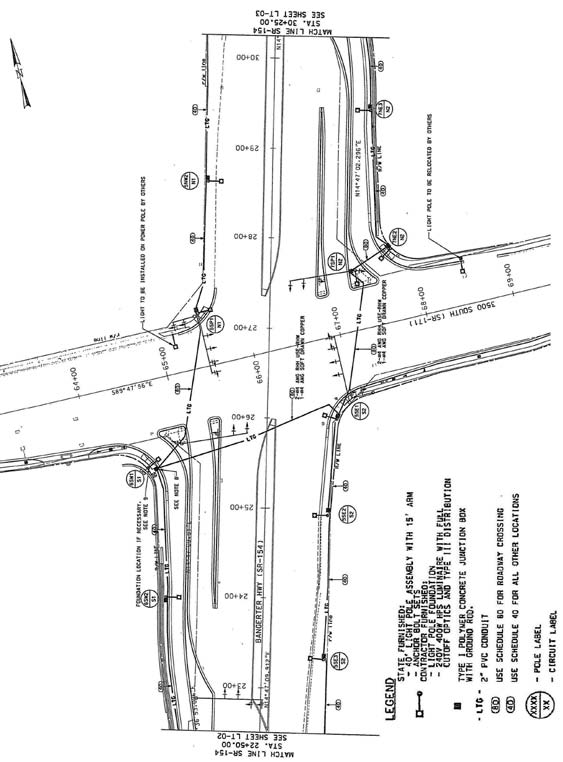
Source: Utah Department of Transportation
Figure 50. Illustration. Intersection lighting plan for a DLT intersection in Salt Lake City, UT.
Prior to the opening of any alternative design, it is important to conduct public outreach to inform and educate the public about the proper use and benefits of the new design. Media campaigns through local newspapers, television, and public meetings can be effective methods to inform the public. Figure 51 is an example of a pamphlet used by UDOT to provide information about the DLT intersection design. Once the intersection is open to the public, it is important to monitor driver behavior and utilize law enforcement as necessary to reduce illegal and unsafe actions.
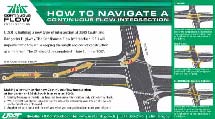
Figure 51. Illustration. DLT intersection instruction card for UDOT. (31)
2.11 APPLICABILITY
As with all the designs described in this report, the DLT intersection design is applicable under certain conditions but not appropriate for all conditions. A primary reason to choose the DLT intersection instead of a conventional design is the ability to process higher intersection volumes, especially left-turn volumes and through volumes. In a suburban or urban setting, a DLT intersection design is an attractive choice on arterials where traffic volumes are at or beyond capacity and when there is balanced traffic flow on the DLT approaches.
Replacing a conventional intersection with a full DLT intersection can produce results on the order of magnitude of a 50 to 85 percent reduction in average intersection delays and a 10 to 25 percent increase in intersection throughput. Replacing a conventional intersection approach with a partial DLT intersection can produce results on the order of magnitude of a 30 to 40 percent reduction in average intersection delays and 10 to 20 percent increase in intersection throughput. Some of the situations where a DLT intersection may be suitable are as follows:
- If the volume to capacity ratio (v/c) is greater than 0.8 on two opposing intersection approaches.
- If the cross product of left-turn and opposing through vehicles is greater than 150,000 on two opposing intersection approaches.
- If left-turning volume is greater than 250 veh/h/lane and opposing through volume is greater than 500 veh/h/lane on two opposing intersection approaches.
- If an intersection is heavily congested with many signal phase failures.
- If left-turn queues at an intersection spill beyond the left-turn storage bays.
Designers should consider the DLT intersection as an available alternative in areas with chances of significant development within the design lifetime of the project. Having the DLT intersection configuration in place before a corridor develops alleviates much of the uncertainty regarding business impacts as well as the right-of-way acquisition issues. A DLT intersection may limit access to parcels located on four quadrants of the intersection. Right-of-way availability is a factor that is a disincentive for implementing the DLT intersection.
Although there is insufficient empirical evidence of crashes experienced at DLT intersections, DLT intersections show promise in terms of safety benefits. There are theoretical reasons to expect collisions to decrease with a DLT intersection, particularly those involving left-turning and opposing through vehicles.
2.12 SUMMARY
The distinguishing feature of a DLT intersection is the relocation of the left-turn movement. The DLT intersection shifts left-turning vehicles to the left side of opposing traffic prior to the intersection, which consequently eliminates the left-turn phase for the approach at the main intersection. As such, DLT intersections offer several advantages compared to conventional signalized intersections for certain traffic conditions. Compared to a conventional intersection design, a DLT intersection design offers operational and safety benefits. Other benefits may include reductions in auto emissions and in travel time for selected movements in the DLT intersection.
DLT intersections offer improved operational performance compared to conventional intersections, particularly for relatively large left-turn and through volumes. The operational analysis conducted as part of this research and by others indicates that the operational benefits of the DLT intersection increase as traffic volume increases. Simultaneous movement of the left-turn and through traffic also improves progression of traffic platoons and increases vehicular throughput. Other operational improvements include reduced vehicle delay, reduced queue lengths, fewer stops, and increased capacity.
From a safety perspective, the DLT intersection has slightly fewer conflict points compared to a conventional intersection. Existing DLT intersections in New York, Maryland, Louisiana, and Utah are operating successfully for various periods of time with no reported safety deficiencies.
The DLT intersection also has benefits compared to a grade-separated interchange. The DLT intersection occupies a smaller right-of-way, is less costly, requires less time to construct, and offers comparable improvements in capacity and delay.
Agencies should, however, recognize the specific limitations associated with the DLT intersection design. Compared to a conventional intersection, a DLT intersection requires more right-of-way, is more expensive, presents counterintuitive movements for drivers, creates additional challenges for pedestrians, and is limited in the accommodation of U-turns and access to adjacent land parcels. Any of these issues that are significant for a specific location (such as where high pedestrian volumes are expected) may be reason enough for the highway agency to decide against a DLT intersection.
A DLT intersection has a larger footprint compared to conventional intersections, which can result in significant costs if additional right-of-way is required, particularly in urban areas. With right-of-way restrictions, it can be difficult to widen or add lanes at a DLT intersection; therefore, careful planning is required during the initial design of a DLT intersection. Other costs relate to increased materials and the additional signs and signals. Additional signals can become a significant cost, particularly for a full DLT intersection with left-turn crossovers on all four approaches. The higher construction costs associated with the DLT intersection are likely offset to some extent by safety and operational improvements; however, this should be explored on an individual basis through additional analysis.
With the unusual geometry, a DLT intersection can cause several problems during inception to users familiar with the conventional four-legged intersection. The left-turn movement prior to the intersection and pedestrian movements may be particularly confusing. Public information and educational campaigns prior to opening a DLT intersection can help mitigate some of these concerns. Additionally, signing and marking of a DLT intersection entails significant differences from a conventional intersection. Emphasis must be given to wrong-way pavement markings and signing to warn drivers of restrictions. Overhead and post-mounted signing should be placed to provide sufficient guidance, particularly for left-turn crossovers.
Another limitation of DLT intersections is that vehicle movements are more restricted compared to conventional intersections. U-turn movements are restricted at the main intersection; however, if the median is wide enough, U-turn movements on the major road can be provided at the left-turn crossover or between the left-turn crossover and the main intersection. Also, access to adjacent parcels is more restricted compared to a conventional design, which can adversely affect local businesses or residents.
Pedestrian movements are also more restricted at a DLT intersection compared to a conventional intersection design. Pedestrians experience counterintuitive traffic movements and may be forced to utilize a multiple-stage crossing, which can increase overall crossing time. Depending on the crossing scheme, pedestrians may cross “diagonally” between refuge islands adjacent to the left-turn lanes. These pedestrians walk between left-turning and through traffic. This type of movement places moving traffic on two sides of pedestrians, which can be particularly hazardous to pedestrians with visual or cognitive impairments. Wider median islands and/or wider outer separations may be needed to better accommodate pedestrians.
At the time of this report, applications of the DLT intersection were identified in Maryland, Louisiana, New York, Missouri, and Utah. There have not been any major issues with the installation of DLT intersections in these States. Based on the operational and performance to date, it appears that the DLT intersection is a viable alternative to the conventional intersection design, particularly where traffic demand approaches or exceeds the capacity of conventional designs.
|
